
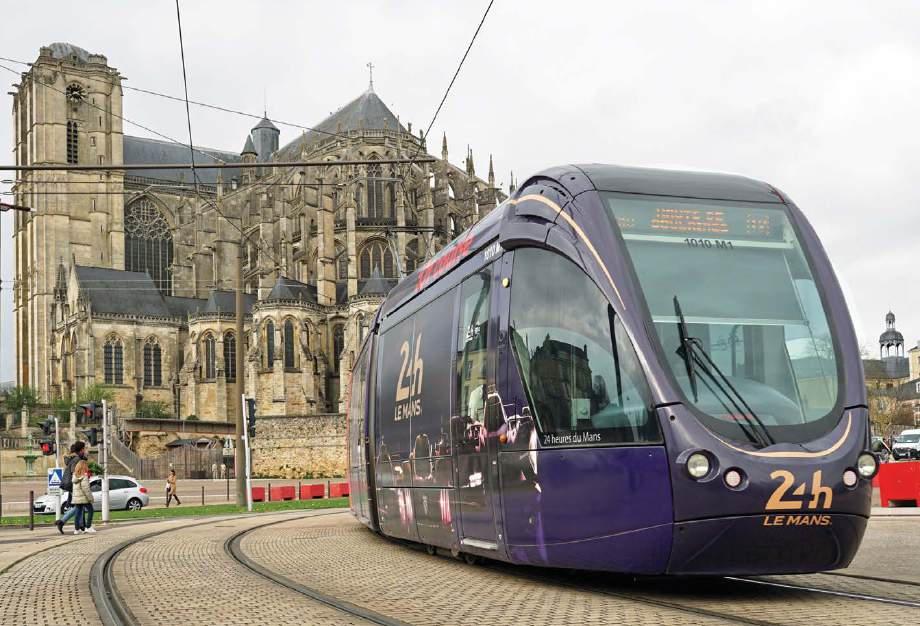

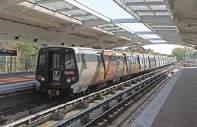







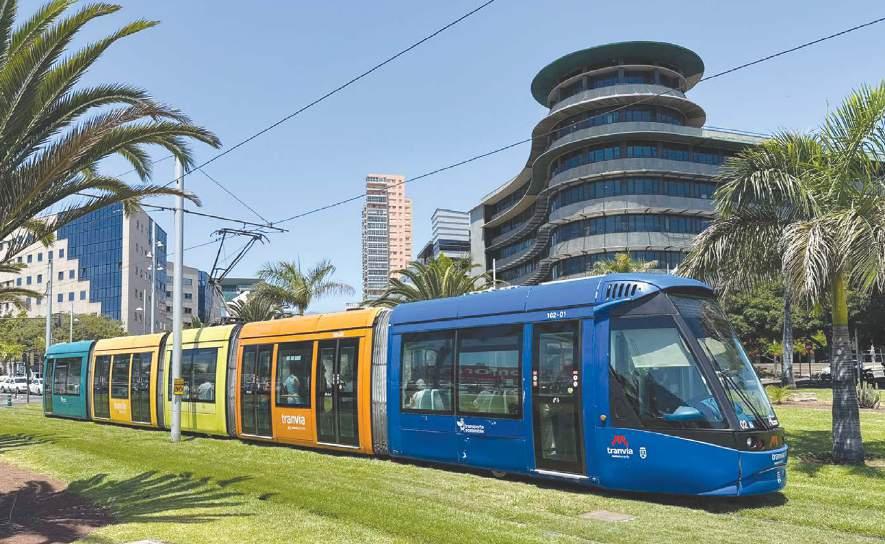
TWO days of interactive debates... TWELVE hours of dedicated networking... ONE place to be
Join key decision-makers, professionals and industry experts as they gather for two days of debate centred upon how new technologies are driving progress in sustainable transport.
For 2026 we are taking the European Light Rail Congress back to the beautiful Canary island of Tenerife, home of the Metrotenerife light rail system.
Metrotenerife provides modern and efficient public transport, with safety and the environment being key factors that contribute to improving the quality of life of the citizens of Tenerife and the surroundings. There are some very exciting expansion plans with their current lines in the North of the Island growing, as well as building new lines to connect more areas of the island and reduce the need for cars and reduce both congestion and pollution.
As an attendee, you will experience: Two days of presentations, panel debates and discussion from some of the sector’s most innovative and forward-thinking suppliers, manufacturers and operators, plus an expansive exhibition hall within the Espacio Mutua Tinerfeña in San Cristobal de la Laguna, which is very close to the tramway. An evening networking reception for delegates to maximise their networking opportunities is also included, along with an exclusive behind the scenes depot tour hosted by Metrotenerife. Convenient accommodation to the venue is very close with one hotel just 45 metres away, and another 450 metres further.
With bespoke sponsorship and exhibition packages also available, there has never been a better time to place yourself at the very heart of European light rail.


11-12
March
2026



NEWS
328
First train for Malaysia – Singapore link unveiled; Ireland aims for ‘Luas 2050’ plans.
UKLRC REPORT
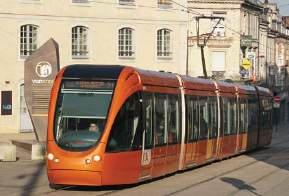
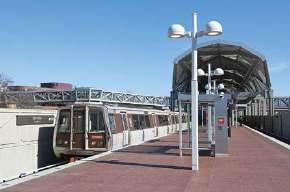
S y STEMS fACT fi LE : LE MANS
333
Richard Foster reports on the renewed sense of optimism at this year’s Conference.
WASH i N gTON
349
Neil Pulling visits the home of the world’s most famous road race, but inside the city, it is light rail that forms the core of a solid transportation network.
WORLDW i DE REV i EW
340
Andrew Grahl provides an update of transit around the capital city of the US.
L i NK i N g UP f LORENCE
Early 2025 saw the opening of the Italian city’s latest T2 extension. Andrew Thompson looks at plans for this Tuscan centre that will help it to manage both residents and large numbers of tourists.
C HEMN i T z
It recently opened a new southern extension; TAUT visits this German city.
343
346
355
New lines to open in Wien; Roma prepares for Tiber tunnel; Bratislava extension begins operation; Hitachi signs Sheffield Supertram deal; San Francisco F-line avoids service cuts.
A TR i BUTE TO g EO ff RE y CLAy DON 358
The LRTA and UKTram remember a stalwart of the UK light rail industry whose great sphere of influence has left a lasting legacy.
CLASS i C TRAMS: CHARLERO i 360
Mike Russell explores an imaginative scheme from Belgium that has more than a few surprises in store.
We’ve been in the wrong, admits the UK

It’s always better late than never. Tracy Brabin, the elected Mayor of the UK’s West Yorkshire region, says that the penny has dropped that light rail is a major contributor to the economic well-being of the nation’s major cities, and maybe some smaller ones as well.
Her upbeat speech that opened the 19th Annual Light Rail Conference in her home city of Leeds confirmed my comment in the last issue that we will indeed turn the corner if whoever is the ruling party at the end of the decade does not do a U-turn on public transport. This is always the great unknown.
While the emphasis always seems to be on new build, conference delegates heard how there is increasing interest in the dual use of existing heavy rail routes, and closer integration with buses (soon to be all-electric) to create the ultimate seamless journey into the suburbs where fixed track may never be justified on usage or cost grounds.
In this issue, cast a glance at the news item about the opening of a short light rail line in North Korea, although censorship has denied us some hard facts. What we do know is that it’s appropriately sited at the beach resort close to birthplace of its supreme leader Kim Jong Un, which westerners are not allowed to visit. How many other world top dogs have their own tramway?
The next big event in everyone’s diary is the Global Light Rail Awards at the prestigious Bloomsbury Ballroom in London on Wednesday 1 October. We have received another large number of entries, and the panel of expert judges is busy studying them all. We hope you’ll be there to find out who are this year’s worthy winners.
Matt Johnston, Editor
COVER: Alstom Citadis 302 1010 in a livery marking the centenary of the Le Mans 24-Hour Race. The line 2 opening in 2014 took the system past the imposing Cathédrale St. Julien du Mans. Neil Pulling
rail transit Association

SEPTEMBER 2025 Vol. 88 No. 1053
www.tautonline.com
EDITORIAL
Editor – Matt Johnston matt@mainspring.co.uk
Associ At E Editor – Tony Streeter tony.streeter@mainspring.co.uk
WorldW id E Editor – Michael Taplin miketap@mainspring.co.uk
sEN ior c o N tributor s –Howard Johnston , Neil Pulling
WO rldW id E C ONT rib UTO r S r ichard Foster, Andrew Grahl, Andrew Moglestue, Herbert Pence, Mike russell, Nikolai s emyonov, Alain s enut, Andrew t hompson, Witold urbanowicz, bill Vigrass, t homas Wagner, Philip Webb.
Productio N – Lanna Blyth tel: +44 (0)1733 367604 production@mainspring.co.uk
d E si GN – Debbie Nolan A Dv ERTI s I ng
co MME rci A l M ANAGE r – g eoff Butler tel: +44 (0)1733 367610 geoff@mainspring.co.uk
Tramways & Urban Transit
13 o rton Enterprise centre, b akewell road, Peterborough PE2 6X u u K
Tramways & Urban Transit is published by Mainspring on behalf of the lrtA on the third Friday of each month preceding the cover date.
LRTA MEMBERSH i P (with TAUT subscription) Tramways & Urban Transit is sent free to all paid-up members of the l ight r ail t ransit Association.
lrtA WE bsit E AN d di A rY Tim Kendell webmaster@lrta.org meetings@lrta.org
sU bsc RI p TIO ns, MEM b ER s HI p A n D b Ack I ss UE s lrtA Membership s ecretary ( d ept t06), 38 Wolseley road, s ale M33 7Au, u K. tel: +44 (0)117 951 7785 membership@lrta.org Website: www.lrta.org f OR c OR p ORATE sU bsc RI p TIO ns v I s IT www.mainspring.co.uk
LRTA RE gi STERED OffiCE 13 o rton Enterprise centre, b akewell road, Peterborough PE2 6X u, u K Private company limited by guarantee, No. 5072319 in England and Wales.
lrtA cHA ir MAN – Paul Rowen chair@lrta.org
© lrtA 2025
Articles are submitted on the understanding they may also be used on our websites or in other media. A contribution is accepted on the basis that its author is responsible for the opinions expressed in it, and such opinions are not those of the LRTA or Mainspring. All rights reserved. No part of this magazine may be reproduced or transmitted in any form by any means, electronic or mechanical, including photocopying, recording or by any information storage and retrieval system, without prior permission in writing from the copyright owner. Multiple copying of the contents of the magazine without prior written approval is not permitted.
Transport Infrastructure Ireland has revealed a proposal for Dublin’s Luas system that could lead to new lines being built every couple of years. ‘Luas 2050’ includes new orbital tram lines and even extensions to Bray, in County Wicklow.
The programme includes two projects that are already in development: the first is a proposed 3.9km (2.4-mile) extension of the Green Line
from Broombridge to Charlestown via Finglas, which also includes a 350-space park-and-ride site located near the M50 motorway. This project has been approved by Ireland’s Cabinet and could open in 2031.
A longer-term prospect is an east-west line from Lucan/ Adamstown to Dublin city centre. Designs for the preferred route are being prepared and are due to be unveiled in 2026.
‘Luas 2050’ includes three further potential new lines –Inner North Circle, Orbital West and Inner South Circle – which would together create an orbital network. According to the plan, nine suburbs around Dublin could be connected by new lines, while the Green Line could be extended south from Brides Glen to Bray.
‘Luas 2050’ is a response to the current system being at full capacity. The use of 55m trams
has been ruled out due to the conflict with road traffic in Dublin city centre.
Transport Infrastructure Ireland told The Irish Times that “taking a strategic look ahead to 2050 allows for the public and decision-making bodies such as the Department of Transport and National Transport Authority to see where potential investments can be made to support the country’s future growth and development.”
Test running on the first stretch of Astana’s automated light metro line should start in September; a passenger service between the eight stations on the Kazakh capital’s system is expected to begin before the end of 2025.
Astana has been the Central Asian country’s capital since 1997, replacing Almaty. It was temporarily renamed Nur-Sultan (2019-2022) in honour of the Republic’s former president. A 16.4km (ten-mile) light rail line was planned for completion by 2013 but construction had yet
A hydrogen-powered tram has started operation on a 300m stretch of Gongnong Road (Hongqi Street) in Changchun, northeast China. What has been dubbed ‘Hydro-Chun’ made its debut on 2 June before entering service on 10 June.
This café tram is intended to serve the city’s growing tourist industry. It features one of the system’s 1940s bogie trams, which has been re-bodied by CRRC Changchun.
It uses a Guohong Hydrogen Energy fuel cell. According to the Youth China news outlet, the tram has a “single refuelling range exceeding 320km [198 miles] and an average energy consumption of just 1.5kWh per kilometre”.
to start in 2020, when President Nursultan Nazabayev cancelled the project on cost grounds.
The scheme was restarted when agreement was reached with China Railway Group for a 22.4km (14-mile) 1435mmgauge automated metro, linking Nursultan Nazabayev International Airport with Astana Nurly Zhou railway station. It is to have 11 stations. CRRC Tangshan is producing 19 four-car 60m third-rail trains.
The Innoprom-2025 international trade fair took place in Yekaterinburg, capital of Russia’s Sverdlovsk region, from 7-11 July.
Sinara Group showed off its three-section, batterypowered 71-233, which can run autonomously for 3km (1.9 miles). Due to be assembled in Yekaterinburg, this 28.7m tram can reportedly accommodate 308 passengers (70 seated).
PK Transportnye Systemy (PKTS) exhibited a double-ended 37.5m 71-952 Voyevoda. This boasts space for 280 passengers and was due to start testing after starring in an exhibition at the PKTS Sankt Peterburg (Saint Petersburg) factory.
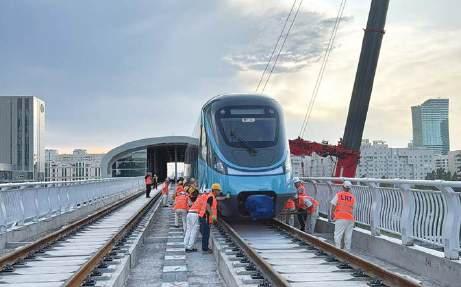
Russia’s longest tram has begun testing in Yekaterinburg. UstKatavsky Vagonstrojitelny Zavod (UKVZ) has built the 39.7m five-section 71-665 Arktura tram, which has capacity for 270.
It has been running on line 18, between the city centre and the south-west suburbs, but has had to operate with some doors switched out as it is too long for
the city’s loading islands. Yekaterinburg plans to modernise its 400-strong tram fleet, which mostly comprises high-floor Tatra T3 cars from the 1970s, plus two modern 71-911 low-floor vehicles. It ordered 15 25.8m 71-639 Kastor trams from UKVZ earlier this year. A prototype has been running since February 2024.
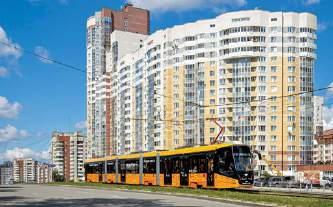
The first train for the Singapore – Malaysia rail link was unveiled at the Singapore Rail Test Centre on 30 June. It is to be commissioned at the SRTC, with trial running to take place next year; the long-awaited line is due to open in December 2026.
The link’s route will run across the border between Singapore, the city state at the tip of the Malay peninsula, and Malaysia’s second-largest city at Johor Bahru. This addition to the Singapore mass transit system was first proposed in 1990, but it was not until 2010 that the leaders of the two countries agreed on a rapid transit link that would ease traffic congestion on the Johor – Singapore causeway. Work did not start until November 2020 (Singapore) and January 2021 (Malaysia).
The 4km (2.5-mile) line involves a 25m-high bridge across the Johor Straits, as well as an elevated alignment to meet the Singapore metro at Woodlands North and an underground alignment to the Bukit Chagar terminus.
End-to-end running time will

be five minutes. Immigration checks for both countries will take place at the departure station. The total cost of the project is SGD3.24bn/ MYR10.7bn (EUR2.2bn).
Signalling is being supplied by Siemens to support GoA4
automation and the depot will be at Wadi Hana in Malaysia. A contract for eight 76m four-car trains was awarded to CRRC Zhuzhou Locomotive Company in 2021. Each will carry up to 1000 passengers (393 seated).
HyundaiRotem/Woojin Industrial Systems unveiled the first battery-powered trams for Seoul’s Wirye Line Urban Railway Construction Project on 2 July. The batteries in these ten five-section low-floor trams are charged by fuel cells.
These vehicles are to work the two-line 5.4km (3.4-mile) 12-stop system, which is to be the South Korean capital’s first tramway for 57 years (its first-generation tramway ran 1899-1968). The KRW261.4bn (EUR162m) project is to provide links to three metro stations on lines 5 (Mancheon) and 8 (Nam Wirye and Bokjeong).
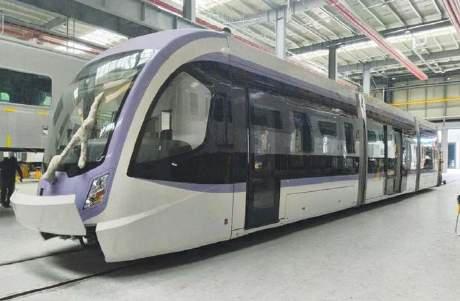
Construction started in 2022 and the network is due to open in September. However, this could be delayed because there are differences of view between the Metropolitan Government (builder and operator) and the Seoul Metropolitan Police Agency over the legal status of the tramway where it operates on the highway. The Ministry
Alstom has halted the production of tram bodies for HeiterBlick GmbH after the failure of HeiterBlick’s self-administration, initiated in April (TAUT 1050). Leipzig Insolvency Court initiated official insolvency proceedings on 1 July.
Some commentators have suggested that this will put the future of the Sachsentram – the 155 trams that HeiterBlick has been building for Leipzig, Zwickau and Görlitz in Saxony –in doubt.
A statement from Alstom said: “The production of car bodies has been stopped because HeiterBlick is not fulfilling key elements of the contract.”
According to the Die Sachsen news portal, HeiterBlick has not commented on the situation other than a spokesperson saying: “HeiterBlick is interested in continuing its cooperation with Alstom and is complying with its obligations within the framework of insolvency law.”
Meanwhile, Saxony’s Ministry of Economic Affairs has said the cessation of supply of bodies from Alstom’s Gorlitz factory is a temporary measure, rather than a termination. It said: “The insolvency application offers the company a wide range of opportunities for comprehensive consolidation and realignment.”
Ukraine’s city of Kamianske has placed an order for 17 new trams, thanks to finance from the European Investment Bank’s Ukraine II programme. The order for these 15m bogie trams is worth EUR14.167m and Tatra-Jug, a manufacturer set up in 1993 to ensure the availability of Tatradesigned trams after the end of the former Soviet Union, is to deliver the first towards the end of 2025; deliveries are to be completed in 2026.
of Land, Infrastructure and Transport has been asked to adjudicate on differences between the Road Traffic Act and the Railway Safety Act.

CAF wins French order CAF has won a EUR218m contract to supply new trams for Syndicat Mixte des Mobilités de L’Aire Grenobloise in Grenoble in France. The order for the 38 new trams has an option for nine more.
The 45m air-conditioned 100% low-floor cars will replace the 29m Alstom TFS-2 stock on the system from 2028. They are designed to carry up to 281 passengers (82 seated) and are to be built in France at the Bagnères-de-Bigorre factory. This is already processing orders from Montpellier, Marseille and Tours, and more than 30 additional new employees are to be recruited.
This is one of two new contracts won by the Spanish manufacturer in France, the other being for 14 new regional trains based on its Coradia Polyvalent platform for the Bourgogne-Franche-Comté Region.
Australia’s Adelaide Metro is to be severed for six months from 2 August to enable work on tramway grade separation projects to take place. The Glenelg line will be closed between South Terrace (Adelaide) and Moseley Square (Glenelg) until late January.
This is to allow the existing Marion Road/Cross Road and Morphett Road level crossings to be replaced by bridges. These new structures will take the Metro over road widening and improvement works.
Free city tram services between South Terrace and the Royal Adelaide Hospital, and between Adelaide Entertainment Centre and Adelaide Botanic Gardens via King William Street and/or North Terrace will be maintained. Trams for this service will be stored on part of what was once the main line in the Park Lands beyond South Terrace.
Delivery of the first of eight new Alstom Citadis is the first step towards the French city of Besançon expanding the capacity of its tramway system.
Tram 901 arrived on 5 June and operator Keolis has started night testing.
A further four will arrive by the end of September, and the final three in 2026. The new fleet will permit headways on the line to Hauts de Chazal to be reduced: from 12 to ten minutes next year and then to five minutes in 2027.
These 32.5m trams are part of a joint order for 22 with Toulouse and Brest. They will carry 201 passengers compared to the 140 that can fit in Besançon’s 19 23m CAF Urbos 3s. The new trams are designed to consume 25% less
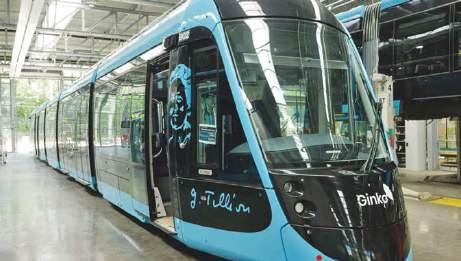
energy than their predecessors, despite being air-conditioned. They are also expected to be cheaper to maintain.
Besançon’s first-generation tramway operated between 1897 and 1952. The city’s 14.5km (nine-mile) second-generation system opened in August 2014, with two lines carrying 36 000 passengers per day. As with the existing fleet, each of the new trams is named after notable local figures.
Amsterdam’s transport operator
GVB is to run the Netherlands’ capital’s buses, trams and ferries until 2036. It was announced that GVB won the new concession on 1 July; a new timetable, with a 4% increase in services, will be introduced.
GVB was set to have been awarded the concession as far
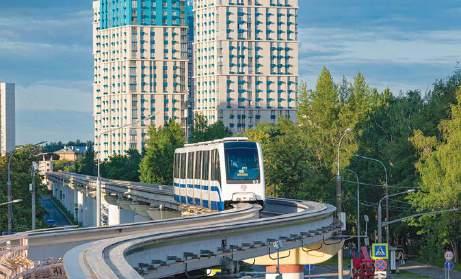
ABOVE:
back as 2017. However, in 2024, Vervoerregio, Amsterdam’s transport authority, questioned GVB’s proposals. A revised plan was submitted last November.
Melanie van der Horst, Chair of the Vervoerregio, said: “What I felt was lacking in the previous bid was courage. That’s in there now.”
• The Dutch government has voted to scrap EUR335m in cuts to regional public transport. Instead, a reduced total of EUR110m is to be shaved from the transport budget across Amsterdam, Den Haag (The Hague) and Rotterdam. However, further savings are likely to be implemented in 2027.
The 4.7km (three-mile) monorail in Russia’s capital Moskva (Moscow) operated its last services on 27 June.
A referendum was held earlier this year and 71% of voters agreed that the monorail should be closed and the route converted into an elevated park.
Only the first stage of what was intended to be an 8.6km (5.3-mile) system opened on 20 November 2004, with work having started in 2001. It linked Timiryazevskaya in the west to Ulitsa Sergeya Eyensteyna in
the east via Vystavochny Tsentr and VDNkH (the All-Russia Exhibition Centre).
Initially, services ran 10.0016.00 every 30 minutes. The line was declared part of the metro network in January 2008, running 06.50-23.00, with a nine-minute headway. While operating as metro line 13, its passenger numbers dropped to 6000 passengers per day on weekdays and 7000 at weekends. In May 2017, it reverted to running 10.00-16.00, with a 20-minute service.
Supreme leader officiates at east coast line opening in Wonsan Kalma
Kim Jong Un, North Korea’s supreme leader, formally opened the 8.5km (5.3-mile) tramway at Wonsan Kalma on 24 June.
The event at the beach resort in Kim Jong Un’s birthplace, on North Korea’s east coast, was attended by the Russian ambassador. Sources suggest that the resort’s first overseas visitors will come from Russia but that Wonsan Kalma has not yet been cleared for foreigners to visit.
Work on the metre-gauge single-track loop at the resort, which also boasts a railway
station and an airport, started in 2019. Infrastructure work was completed in late 2020 but the effective closure of the resort area during the COVID pandemic suggests that the tramway has never carried passengers. Overhead wires were installed in 2024.
Service is provided by five single-unit bogie trams built by the Kim Jong Thae Locomotive Works, including three with open sides. They are apparently based on the EVO1 from Czech manufacturer Pragoimex. The first passengers were carried on 26 June.
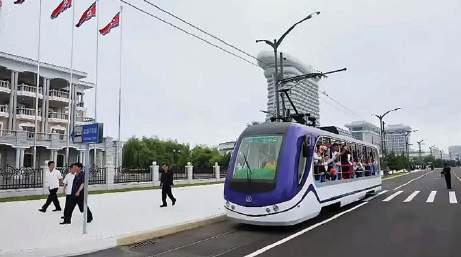
A pair of Polish cities will use European Union contributions to build new tram lines.
The EU is providing partfunding for a PLN800m (EUR183m) project in Szczecin to build a 3.75km (2.3-mile) line. This is to link the southern suburbs with the new University of Technology, with completion expected in 2029.
Meanwhile, in the capital Warszawa (Warsaw), a PLN900m (EUR212m) loan will be used to build new lines to Zielona
Białołęka and Goclaw. The 6.5km (four-mile) line to Zielona Białołęka is to have eight stops and will connect to the existing network at Matki Teresa z Kalkuty and Rembieli ń ska Streets. The 4km (2.5-mile) line to Goclaw is to serve a housing development.
Tenders have also been invited to build the new tram workshops at Koło. This is to replace the facility at Wola, although the new depot is unlikely to open until the 2030s.
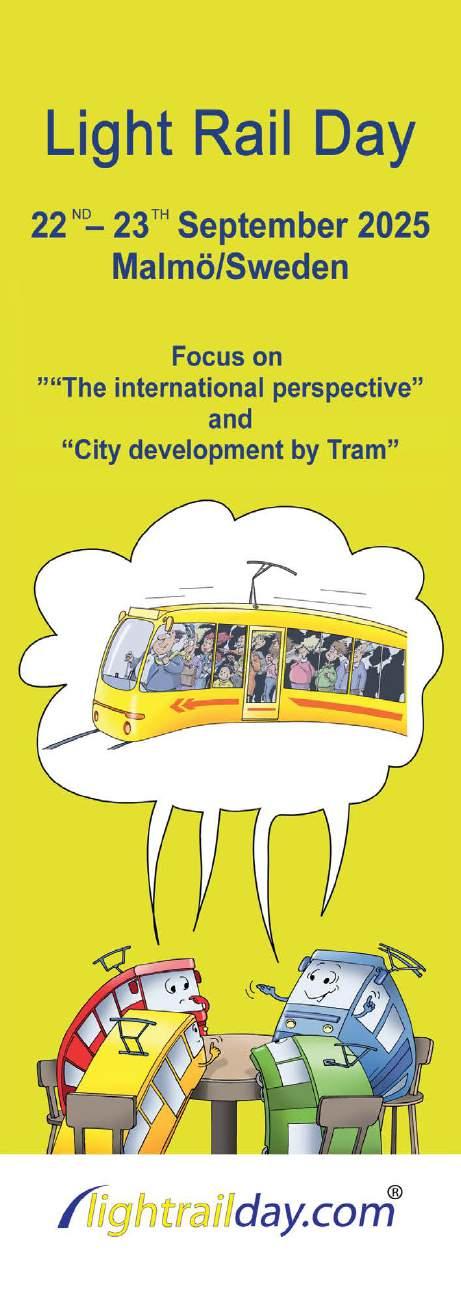
The more people who share information on risks, the safer we will all be. Hearing someone’s safety concerns can give you new knowledge or awareness of a situation. It can highlight risks that you may not have considered before.
Frontline staff are often the first to identify issues. Their experience and real-world understanding can help you get to the root of a problem before it becomes serious.
Put simply, listening well can save lives: active listening – to really hear what someone is saying. At some point, we have all found ourselves thinking about what we are going to say next, or listening out for what we want to hear, when we are supposedly listening. This means we are not paying attention.
But people are not always straightforward in bringing forward information. While some may state something outright, others hint at the problem by asking questions, or make a joke of the situation that reveals more than it seems. Picking up on nuance and asking follow-up questions about minor concerns can reveal the real issues at play.
You might feel that something is not quite right and expect to be hearing more concerns than you are. This is especially true when there is a gap between situations you know are high-risk, or which have the most incidents, and the number of concerns

being raised about them. There could be under-reporting.
Offering a wide variety of reporting channels helps to close the gap, by making it easier for all your staff to raise concerns. If someone prefers to raise their concerns confidentially, CIRAS confidential safety hotline provides that extra listening. Your staff can also use CIRAS to report concerns for other companies.
By listening to workers who speak up with their identity protected, we can give our
members safety intelligence that might have stayed hidden otherwise. Our trained team of listeners ask the right questions so you receive a thorough report.
When you receive a CIRAS report, you can respond and ask the reporter further questions through us. Your response lets the reporter know you are listening. When people believe someone is listening, they’re far more likely to make the right call and report their concerns.
Find out more at: ciras.org.uk/rightcall.
Thousands of organisations in the transport sector are members of CIRAS. We build a strong listening partnership with our members to improve safety. Our confidential safety hotline provides extra listening to help staff make the right call and report their concerns even when they feel they can’t use other channels. When we listen, we learn.

Learn how you can build your listening partnership with CIRAS at ciras.org.uk/rightcall. Scan me We find safety in listening.
Richard Foster rounds up this year’s UK Light Rail Conference in Leeds, which suggested there was a lot to be optimistic about in the coming years.
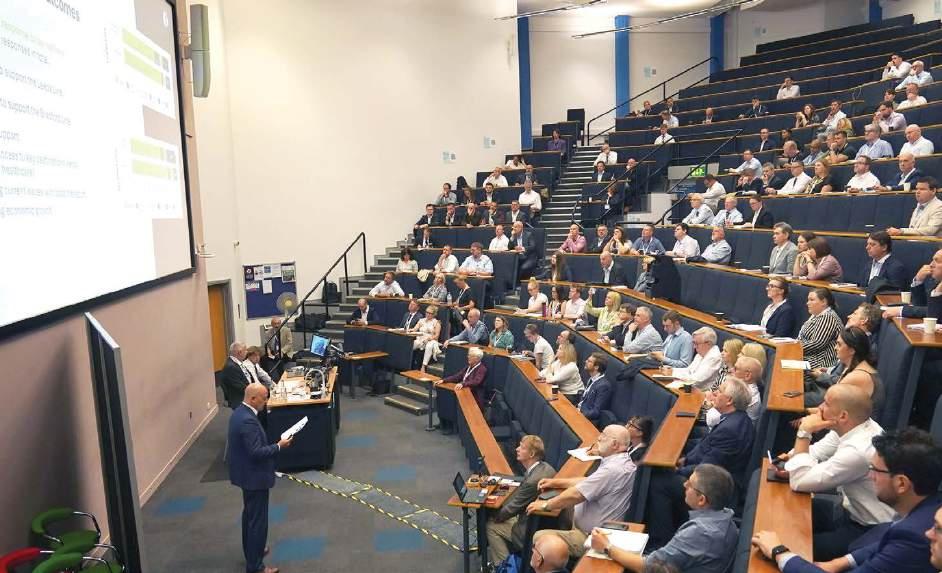
Alot can change in a year.
West Yorkshire Mayor Tracy Brabin opened the 18th UK Light Rail Conference on 17 July 2024, saying that she was “laser focused” on getting construction underway on West Yorkshire Mass Transit by 2028. Much was still undecided, even the route –Leeds to Bradford, certainly, but there was talk of Wakefield and Dewsbury – and still the issue of how was it going to be funded, other than promises of capital released from the cancellation of Phase 2b of HS2.
But when Mayor Brabin stood in pretty much the same spot 12 months on, nearly 5000 local people had already had their say on where the first two West Yorkshire Mass Transit lines were going, and discussions with manufacturers and design consultants had started. On top of that, UK Chanceller Rachel Reeves had committed GBP2.1bn (EUR2.5bn) to the project (TAUT 1052).
There are also increasing signs that areas other than West Yorkshire might ring to the sounds of light rail construction in
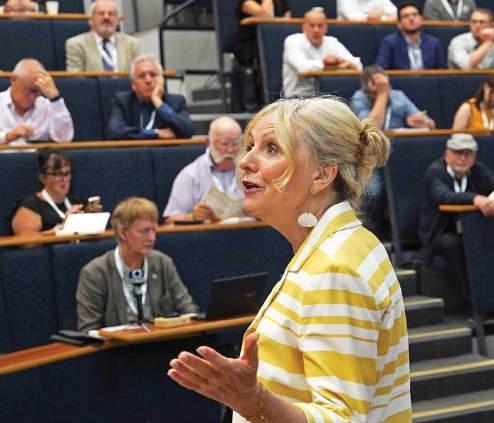
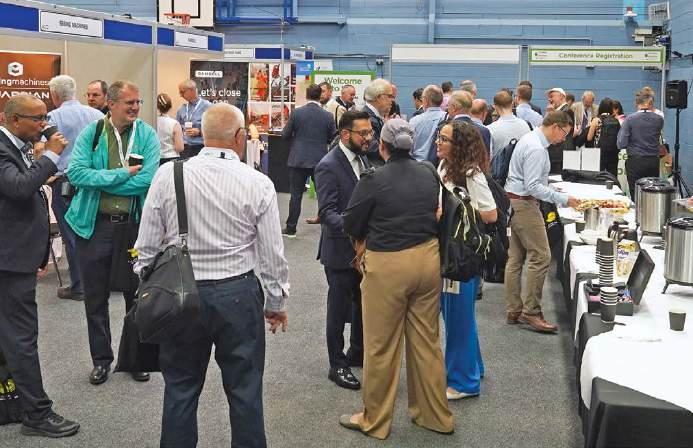
the coming decades…

complementary exhibition area displaying some of the smaller innovations that could transform the industry in years to come. Mayor Brabin opened the conference after introductions by Hall A Chairman, Ian Brown. While expressing her delight in the positive support given to West Yorkshire Mass Transit from local people and government alike (calling it “a regional project but with national and international significance”), Mayor Brabin’s speech introduced West Yorkshire Combined Authority’s new brand: the Weaver Network.
This, she said, is to be an “integrated network of train, tram, bus and bike” intended to become the “first choice of travel for the people of West Yorkshire”.
“the penny is beginning to drop about the transformation light rail can give to the city region.”

“I’ve been coming to light rail conferences since they were in single digits but, for some reason, this year feels a bit more optimistic, largely because of the Chancellor’s [Spending Review]. I get the sense that, at a national level, the penny is beginning to drop about the transformation light rail can give to the city region.”
So said Transport for Greater Manchester’s Chief Network Officer Danny Vaughan at the 19th UK Light Rail Conference on 22-23 July when over 300 delegates from the light rail industry, both in the UK and around Europe, descended on Leeds University’s campus. Speakers, many of whom are leading lights in the UK light rail industry, took to the two auditoriums, while there was a
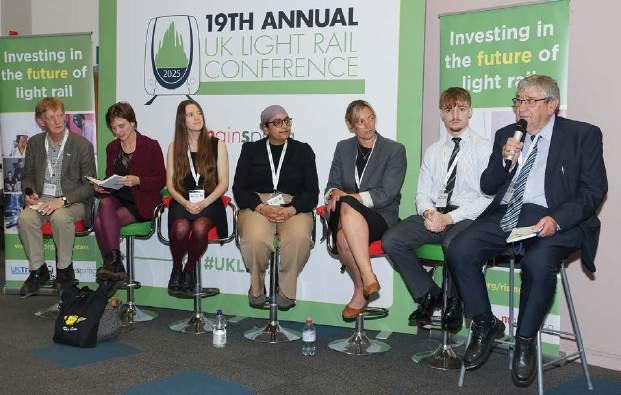
Weaver Network branding, which will replace the famous Metro ‘M’ that was introduced in 1974, is a “bold and modern brand which reflects our history of textile manufacturing, stitching together the diverse cultural fabric of modern-day West Yorkshire and weaving the many and varied journeys we take”.
Mike Birch, WYCA’s Director of Mass Transit, gave an update on mass transit progress. He explained that 70% of those who responded to 2024’s public consultation were in favour of the two routes: the Leeds Line (St James Hospital – city centre – White Rose Shopping Centre) and Leeds –Bradford. The latter would include provision for a connection with the proposed new Bradford station that is planned to replace Forster Square and Interchange.
“In parallel with [the public consultation], we’ve been working on… our Outline Strategic Case, which is the first of the business case steps to government to secure that funding”, Birch said.
He explained how there will be further public consultation on the final Leeds –Bradford and Leeds Line route options, “together with our updated sustainability strategy” and “preferred options… including tram stops, depots and potential park-andride sites”.
From there, an application for a Transport & Works Act Order would be made in 2027 for advanced works to start in 2028, with a view that main construction would begin in 2029.
Construction could soon start in the North East on the Tyne & Wear Metro’s 13km (eight-mile) extension from Pelaw to join the Green Line at South Hylton. Nexus Managing Director Cathy Massarella said that this will give Washington’s 70 000 residents rail access for the first time since the 1960s, via its three new stations – Follingsby, Washington North and Washington South.
She added that North East Mayor Kim McGuinness has “committed half” of the GBP1.85m (EUR2.13m) allocated to the North East in the Spending Review to the project, and consultancy firm Arup has already started on surveys and outline designs. The aim is to open the line by 2033.
Said Massarella: “It’s a big scheme, it’s an expensive scheme, it’s a scheme that we’re
BELOW: Buses were a hot topic at this year’s conference, with a focus on how bus franchising can affect light rail schemes.
The UK Light Rail Conference is always a hotbed of ideas and concepts, and 2025’s was no exception. Unusually, buses were a big topic, and Transport for Greater Manchester’s Danny Vaughan described how punctuality has increased from 70% to 84% since his organisation took control of the region’s services. Both South Yorkshire Mayoral Combined Authority and West Yorkshire Combined Authority are to take control of their respective bus networks from 2027, the latter coming under the new Weaver Network brand. Nexus is also preparing to take on bus services in its area.
SYSTRA UK & Ireland’s Director of Public Transport David Carter’s presentation was particularly timely, covering how bus franchising can affect light rail schemes. He discussed how the modes can complement each other and offered thoughts on how, when planning a new light rail system, each needs to be assessed in order to ascertain where they might compete and how they could be made sustainable in the long-term.
Melanie Corcoran, Executive Director of Transport at SYMCA, explained how barriers to travel are being removed from the Supertram network. This has included making tickets easier – and cheaper – to buy and trialling allowing dog owners to travel with pets. Space for bikes will be included in a new fleet of vehicles due to be introduced in 2032.
Naomi Ward from Mott Macdonald and TfGM’s Luke Bramwell shared their three-phase framework approach to project development. This uses Definition, Assessment – how different options are judged against its criteria – and Sifting Phases, the latter utilising Mott Macdonald’s Investment Sifting & Evaluation Tool as a scoring system. The pair explained how this approach can be used across different projects and to provide evidence for the Transport & Works Act Order process.
Meanwhile, Lindsay Murphy of TXM Consult explained how the ‘U’-shaped curve of asset failure – where failure rates start high at introduction, fall away and then rise again as an asset ages – can be smoothed out by taking a proactive view of maintenance
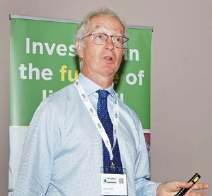
ABOVE: david Carter from sYsTRA discussed how bus and light rail systems can complement each other. He offered thoughts on how the modes need to be assessed to ascertain where they might compete and how they could be made sustainable in the long-term.

ABOVE: Melanie Corcoran, Executive director of Transport at sYMCA, explained how barriers to travel are being removed from the supertram network to better serve local communities.
programmes. Done right, she said, an optimised maintenance programme can deliver greater benefits to passengers, who are no longer affected by breakdowns and failures.
Simon Coulthard and Richard Ellis-Hobbs from Network Rail shared how the concept of the ‘mixed use railway’ is evolving. The infrastructure owner’s three emerging scenarios are helping it evaluate the reopening of railways: whether that’s a limited NR operation (such as Okehampton in Devon), a third-party operator running onto NR metals, or a completely separated operation with cross-platform connections (such as that at Stourbridge). They also explained how NR is working with Greenway Initiative to develop lines on which its range of lightweight rail cars can be trialled,
looking at in various phases but we now have a large chunk of that money.”
Could Cambridge’s on-off relationship with light rail also reach a successful conclusion? Peter Graham, Chief of Staff to Cambridgeshire and Peterborough’s mayor Paul Bristow, offered the prospect of a new light rail line connecting the various science and research parks to the southeast of the city. This would get around the problems that have stopped previous light rail schemes in the city, namely crossing the river Cam and disturbing historic buildings.
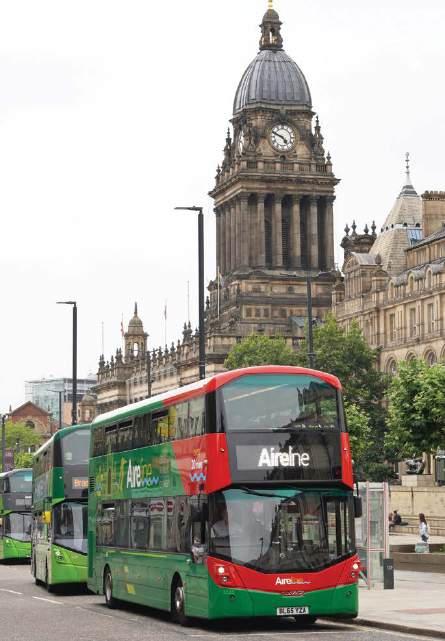
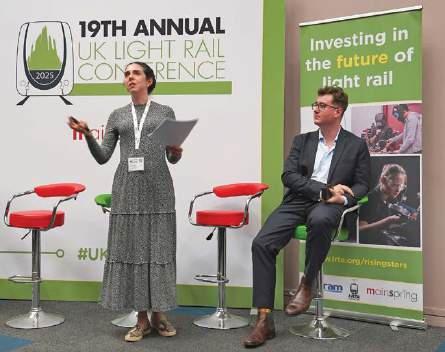
ABOVE: naomi Ward from Mott Macdonald and TfGM’s Luke Bramwell shared their three-phase framework approach to project development.
details of which are imminent.
Finally, Mott Macdonald’s Ian Mackenzie and Muhammad Ismadi explained how getting on site is vital for developing the next generation of light rail civil engineers. While Mackenzie took the opportunity to
“What we’re looking at”, Grant said, “is rather than taking the centre on right at the start, we’re going to actually try to put the spokes of the wheel together before we join them up with the hub.”
There is “genuine grass roots support” for what has been dubbed the ‘Life Sciences Line’, which would take pressure off local transport arteries. While the project is too early in its development to have costs and timelines attached, Grant added that the Department for Transport has been working with Cambridgeshire & Peterborough
also demonstrate Mott MacDonald’s Moata tool for renewals planning, Ismadi spoke of how ‘getting boots on ballast’ had helped him gain confidence in on-site decisionmaking, communication and peoplemanagement skills.

Peter Graham, Chief of staff to the Mayor of Cambridgeshire and Peterborough, offered the tantalising prospect of a new light rail line connecting science and research parks to the southeast of Cambridge: “…we’re going to actually try to put the spokes of the wheel together before we join them up with the hub.”

ABOVE: Austrian firm EYYEs demonstrated its Ai-led RailEye detection system, an easy-tofit front collision warning system that uses Ai to monitor camera images.
One of the features of the UK Light Rail Conference is the ability to see a range of innovative new products and solutions, either in presentation form or in the flesh in the exhibition hall.
For 2025, Austrian firm EYYES demonstrated its AI-led RailEye detection system. This easyto-fit front collision warning system uses AI to monitor camera images while the Moving Off Assistant helps tram drivers decide when it’s safe to move. Chief Commercial Officer Dr Wolfgang Domann explained that the system not only works with a dirty windscreen but that it can detect someone lying in front of a tram.
PCAT and BarChip joined forces to describe the benefits of using macro synthetic fibre in pre-cast concrete rather than steel rods, while Pandrol revealed various solutions for reducing noise and vibration on light rail track. Data, in all its forms, continues to play a key role in light rail. Bilal Mohammed from Keolis Amey explained how Metrolink was using telematics and sensors to monitor everything from the state of the overhead wire to heat levels in axles and lineside equipment cabinets. Laura Ridler and TAUT editor Matt Johnston revealed the surprising levels of data held by Rail Intel. For example, that the cost of global light rail operations is GBP330bn (EUR378bn) while GBP300bn (EUR344bn) is being invested in new light rail construction – and that these figures are changing on an almost daily basis.
There were two presentations based around people: Ampertronic demonstrated how its Auri system uses Bluetooth technology to transmit public address messages to the devices of those with hearing difficulties, enabling them to hear messages clearly. Asistobe, on the other hand, explained how its Alx3 Saas-platform can manage copious amounts of different data sources to make informed, evidence-based transport planning decisions.

ABOVE: Keolis
Amey Metrolink’s Bilal Mohammed explained how Metrolink uses telematics and sensors to monitor infrastructure.

Combined Authority to develop mass transit solutions.
One scheme gaining momentum is Clyde Metro. Simon Nesbitt, Project Director from Mott MacDonald, described this as an “ambitious transformational programme to better connect more than 1.8 million people to employment, education, and health services in and around Glasgow”.
The system is likely to comprise tram or bus and either metro trains or tram-trains to complement existing bus, heavy rail and active travel routes, along with the Glasgow Subway. Nesbitt explained how potential routes were being decided to enable “enhanced connectivity and placebased regeneration”.
Key corridors have been identified and, he explained, a shortlist of four potential networks has been developed. Between now and 2027, the project will go through the Scottish Transport Appraisal Guidance and Programme Business Case processes, while preliminary engineering statements and environmental assessments can take place. From 2027, an application is to be made to secure funding to take the project onto the next planning stage.

ABOVE: Asistobe’s Johan Haveland told delegates how its platform can manage ‘copious’ amounts of data to help make informed transport decisions.
engineering students put together an argument for operating tram-trains on the freight-only ‘South Sub’ line through Edinburgh’s southern suburbs. The team engaged with City of Edinburgh Council, Network Rail and Transport Scotland before undertaking public engagement and then taking its findings to the Scottish Parliament. Away from the proposals and new schemes were plenty of presentations about the work being undertaken on existing networks.
Nicola Small, Coventry Very Light Rail “What a shame that we have to allocate all that time and money to the process rather than the scheme and delivering innovation.”

David King and Eamon Scullion (Jacobs) brought delegates up to date with progress on Cork’s proposed tramway. It also takes the term ‘Luas’ as used by Dublin – Gaeilge for ‘speed’ – and Cork’s residents have had their say on the Emerging Preferred Route.
The Luas, as with many other light rail schemes, is designed to offer improved placemaking to Cork and its suburbs. However, King and Scullion explained that key issues within the city centre will need resolving, such as its “unique subterranean landscape” that’s prone to flooding. It is not clear when work could begin but the Jacobs team envisions a five-year construction period.
Finally, Corey Boyle from Heriot-Watt University explained how a group of civil
Danny Vaughan described Metrolink as Manchester’s “engine of growth” before giving an overview of improvements being made to the Bee Network, including the introduction of tap-in-tap-out payments with bank cards on buses and trams. He said the Bee Network is now moving closer to being integrated with local rail services and is being made safer, thanks to the creation of a new Transport Command with Greater Manchester Police.
He also highlighted several expansion options of which “the extension to Stockport is the most mature”. However, “we need longer vehicles and we need them now”.
Some GBP150m (EUR172m) is being spent on improving the network, and there were two further presentations on the work being undertaken.
That from Ian Watt (of Ridge & Partners) and Mike Groves highlighted a common theme running through this year’s conference: “Everybody loves the shiny new; maintaining the existing is less exciting, it gets you less interest.”
Nexus’ Cathy Massarella said the Tyne & Wear Metro had received “no investment in our assets” between 1980 and 2010. One visible form of investment has now come in the form of the new Stadler Class 555s. Now that these are replacing the old Metrocars, “the signalling is by far and away the most challenging performance asset… the clock is ticking on that one”.
The good news is that the UK government has committed to funding a replacement
system. While the precise amount has not been disclosed, Massarella said a consultancy framework could be put out in September. Improvements can also be made in ways other than buying new trams and signalling equipment. Nexus is implementing what it calls its ‘Smart Ticket Evolution Programme’, which includes a tap-in-tap-out payment system as well as the ability for travel-nowpay-later.
One system that has overhauled its customer offering is the Blackpool Tramway. Although it opened its North Station extension and attracted 4.4m passenger journeys in 2024, this masked a shortage of drivers, increasing costs and the fact that, pre-COVID, the system was attracting 5.4m passengers a year. Coupled to that was the decision to pause the operation of heritage trams.
Blackpool Transport’s Managing Director Jane Cole updated delegates on various improvements made during the tramway’s ‘winter re-set’, prior to a summer relaunch.
The highlight is a new timetable, offering a tram from every ten minutes, seven days a week, with a 15-minute evening service. Blackpool Transport has also formed a new team of customer assistants, and increased the opening periods of its North Station kiosk, while you can now book tickets for the tramway from train operator Northern. Blackpool is also to put its Flexity 2 fleet through a mid-life refurbishment.
It has implemented a limited heritage operation as well, although “big investment” is still needed to bring “everything up to the current legislation”
Funding is needed because the Rigby Road depot “is leaking, the trams themselves need major overhauls and we need to look at what we do with the track” between the depot and the Promenade.
One area of the UK where new light rail construction is taking place is the
A theme that ran through many presentations covered the opportunities brought by increased devolution. The UK’s devolved decision-making process was given a further boost on 10 July when the English Devolution and Community Empowerment Bill was introduced to Parliament.
Martin Fleetwood, consultant with law firm Addleshaw Goddard, gave delegates a look at how decentralised control of transport has evolved, not only in England but in Scotland and Wales too. He said that English light rail schemes are likely to benefit from the greater autonomy the Bill plans for mayors, and because there are likely to be “fewer layers to block a light rail scheme”, as well as “greater [local] powers for raising funds to support light rail schemes”.
WYCA’s Mike Birch explained the significance that the Bill could have for West Yorkshire Mass Transit. The Strategic Outline Case will follow traditional channels through central government but “by the time we get
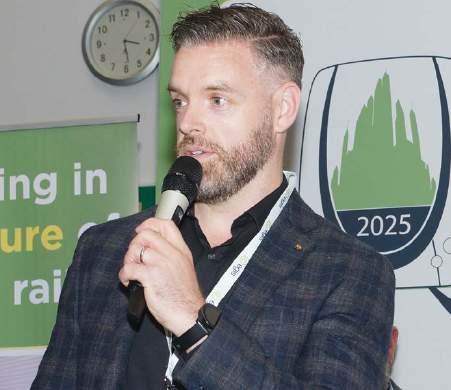
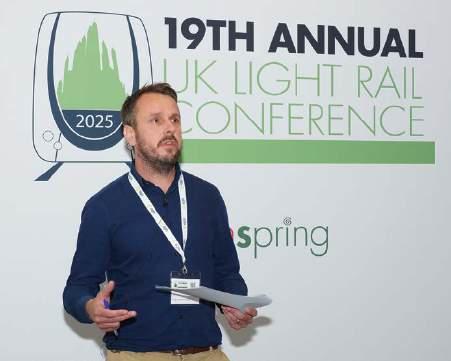
to the Outline Business Case in 2027, we’ll be right on the cusp of the point when devolution comes in.”
This could allow the rest of the scheme to be delivered more quickly.
Peter Grant said the Bill could help Cambridge fulfil its light rail ambitions as Mayor Bristow will get “far more power and ability to push things through”.
Finding ways to break down layers of bureaucracy to spark innovation was a key part of Nicola Small’s presentation on Coventry Very Light Rail. The Coventry Council/ Transport for West Midlands team has worked closely with the Department for Transport to get the trial 220m test track installed, including through the formation of an Independent Review Panel.
“We’ve got a process and we’re working with it and we’re delivering”, she said.
“But for future schemes this needs to change because it’s taken time, it costs money and it takes up loads of resource… what a shame that we

ABOVE: WYCA’s Mike Birch explained the significance that the Bill could have for West Yorkshire.
have to allocate all that time and money to the process rather than the scheme and delivering innovation.”
Danny Vaughan said the GBP2.5bn (EUR2.9bn) allocated to Transport for Greater Manchester by Chancellor Rachel Reeves “goes some way to reaching our ambitions”.
“But it’s not enough,” he said.
“The day after that announcement was made, my colleagues were in Treasury asking for more.
LEFT: david King and Eamon
(pictured) from Jacobs brought delegates up to date with the latest progress on Cork’s proposed tramway.

Our demand was in the region of GBP10bn [EUR11.5bn].”
Devolution brings new challenges. Nexus has gone from operating bus, ferries and light rail around Tyne and Wear to, from 2024, being “the transport delivery arm for North East Combined Authority”. This means it theoretically reaches Berwick-uponTweed in the north and Barnard Castle in the southwest of the region. Lancashire Combined Authority came into being this February, being born out of Lancashire County Council, Blackburn with Darwen Council, and Blackpool Council.
Its economic Growth Plan, says Jane Cole, has “trams in there”, which includes Preston and “extensions in Blackpool” but funding hinges on it becoming a mayoral combined authority, which might not happen until 2027.
“My thoughts are that we need to get the tramway in Combined Authority ownership and make it the Lancashire tramway. It makes sense as we’re the only tramway in the UK that’s not subsidised.”
West Midlands. The Eastside Extension is currently being built to its temporary terminus outside Birmingham’s Clayton Hotel and should be open by the end of 2026. Transport for West Midlands’ Metro Director Das Mootanah and Director of Strategic Partnerships & Integration Sandeep Shingadia explained the significance of the new Birmingham City football ground and sports quarter, and how this and connections with HS2 are driving development of the Eastside extension towards Digbeth. The pair also gave an overview of the Wednesbury –Brierley Hill extension.
A map of a proposed TfWM Mass Transit Network combines existing heavy and light rail lines, together with the emerging Sprint bus network. It also includes potential mass transit routes where either traditional light rail or Very Light Rail could be utilised.
A construction project that has already been completed in the region is the Coventry Very Light Rail’s demonstration line. Hamish Falconer from Colas explained how the only specialist products needed were a special concrete base and speciallydeveloped high viscosity concrete. He showed how the 220m track was laid in just ten weeks using little more than a road planer, a 14-tonne excavator and conventional rail welding equipment.
While the trial is now over, the next stage is to develop an 850m double-track route from Coventry station to Coventry University. Monitors in the existing

section will be left in situ to see how the track-base stands up to heavy road traffic.

Colin Knight, Director of Innovation at Coventry City Council, ended the presentation with an intriguing prospect: that the track-base which is only 330mm deep (and of which 100m-150m can be laid in a day without disturbing underlying utilities) can, with minor modifications, take heavier trams. This is what the 850m demonstrator line will set out to prove.
Said Knight: “That slab can actually be a game-changer in a national light rail programme. What we’ve got here is a system that we know can be laid fast, with minimum disruption and could enable that GBP15bn [EUR17.3bn] that Rachel Reeves announced to be spent far more effectively and at greater speed.”
Light rail in the UK is entering a new chapter. With renewed government backing, bold regional plans and rising demand for sustainable transport, the sector is poised for a renaissance.
But delivery is complex. It takes long-term vision, deep expertise, and a firm grasp of regulatory and operational challenges. That’s where we come in.
We’ve helped shape every modern UK light rail system. From business cases to system and rolling stock design to asset management, we deliver systems built to last.
Talk to us: richard.briggs@mottmac.com Visit: mottmac.com
Designing tomorrow. Supporting today.
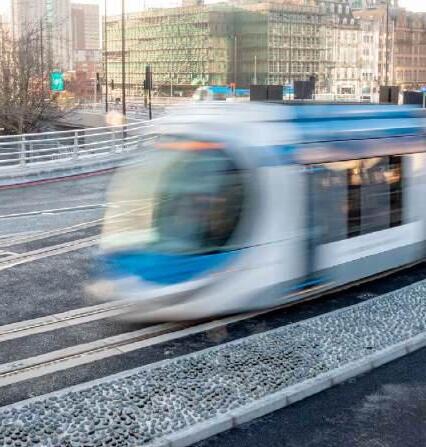
Providing peace and quiet along the
KRAIBURG Relastec, as part of KRAIBURG Holding, specialises in sub ballast mats and bearings for mass-spring systems with its DAMTEC® division. KRAIBURG Relastec has already established itself through numerous international projects with its DAMTEC® products and offers its partners an extensive range of solutions to protect and reduce noise and vibrations in rail traffic.
DAMTEC® products have been tested in recognised external testing institutes and internally for the sometimes very demanding, project-specific conditions and specifications. It goes without saying that KRAIBURG Relastec is ISO 9001, 50001 and 14001 certified, and thus guarantees consistently high quality and complete traceability of its products.
DAMTEC® products are tested according to DIN 45673-5, DIN 45673-7, EN 17282, EN 17682 and other national standards.
Quality products: Produced in harmony with nature
Environmental protection is a key strategic
task at KRAIBURG Relastec. We are fully aware that sustainable growth is only possible if we live up to our commitments and responsibility for environmental protection. That’s why KRAIBURG Relastec has a constant course here: environmental protection is our daily programme!
Manufacturer-related product qualification (HPQ) and Q1 certification at Deutsche Bahn AG
KRAIBURG Relastec has been awarded the ‘Manufacturer-related Product Qualification (HPQ)’ by Deutsche Bahn AG and the ‘Supplier’s Quality Capability’ is classified as Q1 for the product range of sub ballast mats by Deutsche Bahn AG (DB AG).
The HPQ qualifies a manufacturer to produce a particular product using specific processes already described in standards, drawings or other technical documentation. It is required every three years for the annual Q1 certification.
The Q1 certification is the classification of a company, which is audited within the
scope of DB AG’s supplier management with regard to quality capability. As a Q1-supplier of DB AG, one is authorised by the client DB AG to supervise prefabrication services on one’s own responsibility. Project-related external production approvals are no longer mandatory.
Our sub ballast mats comply with the technical delivery conditions and are approved for use in the DB AG network (according to DBTL 918071 and e.g. TM-201510511 LNPF 1).

SBM Sub Ballast Mats
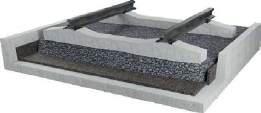

4 · D-29410 Salzwedel damtec@kraiburg-relastec.com · www.kraiburg-relastec.com/damtec PROTECTION,
acc. to DIN 45673-5, DIN 45673-7, EN 17282, EN 17682
AND VIBRATION
MSS Full surface bearings for mass-spring systems
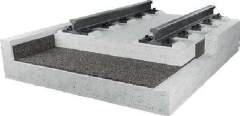
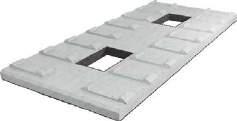
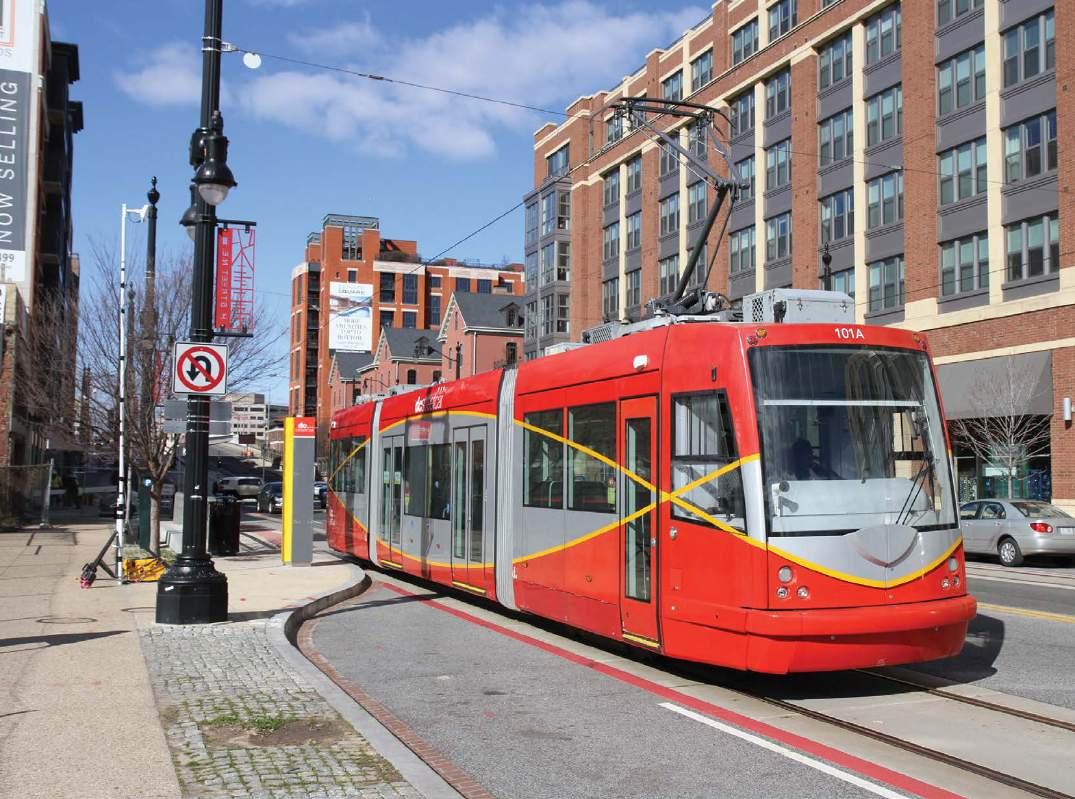
Andrew grahl provides an update on transit around the capital city of the us.
The city of Washington is named after George Washington, the first President of the United States. Washington resides in the District of Columbia, which takes its name from explorer Christopher Columbus. Washington, D.C. is the capital of the US. With the US currently being 249 years old, one can assume there is a rich history of politics and government in Washington. In addition, that history also applies to transportation. Although Washington’s legacy streetcar network closed on 28 January 1962, fortunes have changed and there are electric rapid transit options for the 6.3 million people who currently live in the Washington D.C. metropolitan area.
The Washington Metropolitan Area Transit Authority (WMATA) was created in 1967 to plan, build and operate transit in the capital of the United States, as well as suburban Maryland and Virginia. WMATA operates the Washington Metro, fixed bus routes and paratransit service.
Construction of the metro began in 1969 and the first segment opened on 29 March 1976. The system currently features six lines and 98 stations, and operates over 208km (128 miles) of track in the District of Columbia, Maryland and Virginia. Red Line trains run between the Shady Grove and Glenmont terminals in Maryland; Orange Line trains run from Vienna in Virginia to New Carrollton in Maryland; Blue Line trains run from Franconia-Springfield in Virginia to Downtown Largo in Maryland; Green Line trains run from Branch Avenue in Washington D.C. to Greenbelt in Maryland; Yellow Line trains run from Huntington in Virginia to Greenbelt in Maryland; Silver Line trains run from Ashburn in Virginia to Downtown Largo in Maryland. All lines run through downtown Washington D.C. and provide convenient transfers to all other metro lines.
In downtown Washington and neighbouring Virginia, the metro is known for its repetitive, concrete design and indirect lighting. Designed by Harry Weese, the stations here showcase Washington's
washington’s streetcar opened in 2016, but in 2025 the city’s mayor outlined a plan to replace the line with a ‘next generation streetcar’, or trolleybus system - perhaps marking the beginning of the end for this network. All images courtesy of Andrew Grahl.
neoclassical influence and reflect aspects of the Brutalist architectural style.
Weekday daily metro ridership is 559 400, and annual metro ridership measured 166 million in 2024.
The Metro runs Monday to Thursday (05.00-00.00); Friday (05.00-02.00); Saturday (06.00-02.00), and Sunday (06.00-00.00). The network closes overnight for cleaning and maintenance. Fares vary based on the service, ride length, day, and time you ride. There is an unlimited day pass available for USD13.50 (EUR11.58).
Currently the Washington Metro operates 1208 cars in passenger service: the 3000-series, built by Breda in 1987; 6000-series built by Alstom in 2006; and the 7000-series built by Kawasaki starting in 2015. The 2000-series, built by Breda, were officially retired on 10 May 2024, and a final farewell trip was operated on 19 October.
WMATA’s 8000-series, built by Hitachi Rail in Hagerstown, Maryland, is currently under construction and scheduled for delivery in 2027. A total of 256 cars will be delivered to replace the 3000-series and possibly some of the 6000-series if an option is exercised. A mock-up of the 8000-series ‘Fleet of the Future’ was displayed in the National Mall in the spring of 2024. “Unveiling the Fleet of

the Future marks a major step for Metro”, said Metro General Manager and Chief Executive Officer Randy Clarke.
“We took best practices from all over the world – open gangways, more space, better digital screens for real-time information, enhanced video systems to improve safety, a more sustainable aluminium shell, and eye-catching design – and put them in this train. We are proud of all the improvements we were able to pack into this new fleet and welcome everyone to come out and see the future of America’s transit system”.
The newest station on the Washington Metro is Potomac Yards in Alexandria, Virginia, on the Blue and Yellow lines, which opened to serve a developing community on 19 May 2023. The most recent extension was the 18.5km (11.5-mile), second phase of the Silver Line, travelling west from Reston Town Center to Ashburn in Loudoun County, Virginia on 15 November 2022.
With the aim of improving bus and metro connectivity, WMATA implemented its redesigned bus network on 29 June 2025. Additional Red and Silver Line Metro services were added during rush hour, with increased service spans at weekends.
In late May 2025, Washington’s Mayor Muriel Bowser outlined a plan to replace the DC Streetcar with a ‘next generation streetcar’, which is really a trolleybus, as described during a budget presentation. New vehicles would use the 750V dc overhead, but would not have fixed tracks.
District leaders claim the tramline costs too much to operate and doesn’t go far enough. “The reality of the capital costs involved in maintaining and extending the streetcar are that it is exorbitant”, said D.C. Department of Transportation Director Sharon Kershbaum. “To just replace the streetcars, there are six cars now and they are past their useful life, it’s USD11 million [EUR9.4m] per car”.
With the switch to electric, rubbertyred vehicles, expansion would be more economical. This conversion would happen within the next two years.
Currently the 3.5km (2.2-mile) trolley line starts behind Washington’s Union Station, and provides connections to Washington’s metro, commuter and long-distance trains, plus intercity buses. The line operates along H Street (five stations) and Benning Road (three stations) to Oklahoma Avenue NE, also the location of the car barn.
The line opened on 27 February 2016, and was the first streetcar to operate in the District of Columbia since 1962. Owned by the District of Columbia Department of Transportation, the route carried 835 900 passengers in 2024. The standard-gauge line is operated by RATP Dev USA and is fare-free. DC Streetcar currently uses six streetcars. Cars 101-103 are 12 Trio vehicles, built in 2007 by Inekon Trams in the Czech Republic. Cars 201-203 were built by United Streetcar in Portland, Oregon, as Model 100 in 2013 and are based on the Skoda 10T design. All cars are 2.4m wide and 20m long.
The H Street/Benning Road line was to be one of five streetcar lines in the District. The first was a starter line in the Anacostia
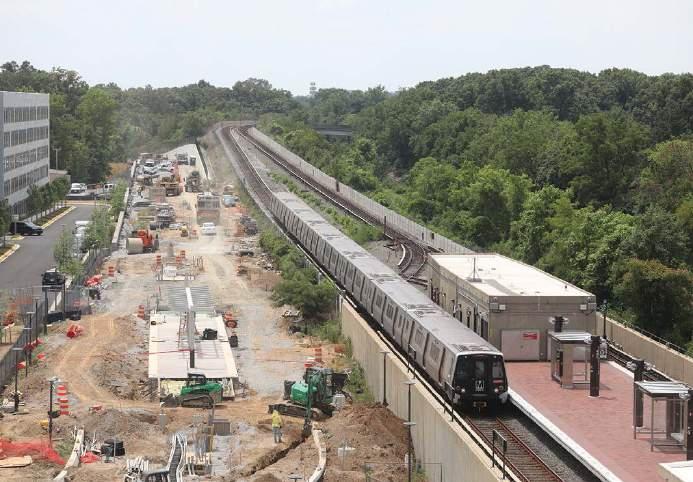
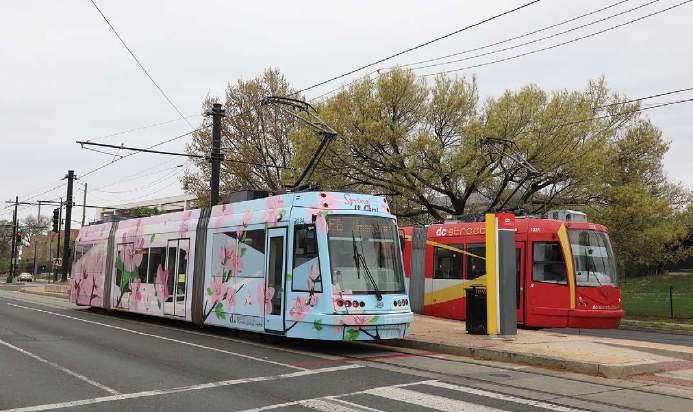
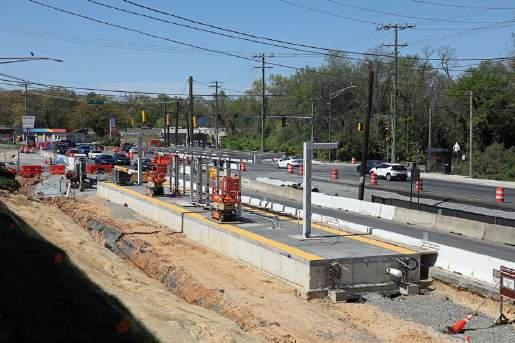
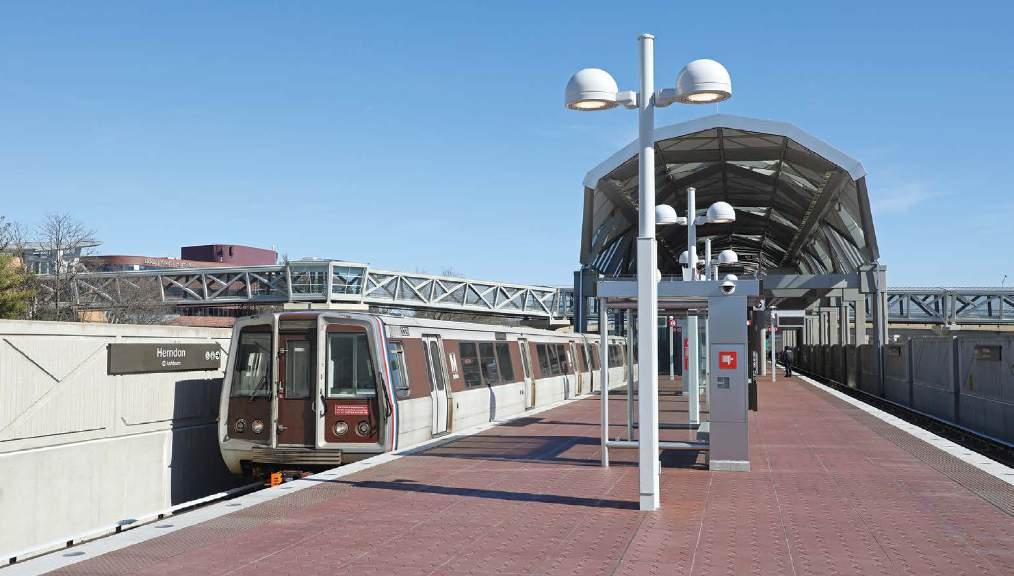
neighbourhood, largely operating over freight tracks. The line was scaled back several times during the planning stage and ground was broken in November 2004. While some parts of the line were built and used for testing before the H Street/Benning Road line opened, the line was never finished and is not currently being constructed.
Additional lines were planned for Georgia Avenue, K Street & Maine Avenue SW.
Currently under construction, the Purple Line is a 26.1km (16.2-mile) 21 station, light rail route. The Maryland line will link the Washington suburbs of Bethesda in Montgomery County and Maryland and New Carrollton, in Prince George’s County. Eleven stations are in Prince George’s County and ten in Montgomery County, Maryland.
Owned by the Maryland Transit Administration, the line will be operated and maintained by Purple Line Transit Operators for 30 years. Around 64 800 daily riders are projected by 2030.
A total of 28 CAF LRVs are scheduled to
operate on the line from its planned opening in late 2027. Cars are 43m long, the longest in the US, with a seating capacity of 80, and a total capacity of 430.
The Purple Line will connect to three Washington Metro lines; Green, Red (twice) and Orange. It will also link three MARC, Maryland commuter rail lines, two Amtrak routes and many local and intercity bus routes. The line will give riders in the northern Washington suburbs a time-saving option of travelling across Maryland to reach a potential destination without having to head into Washington.
Stops will feature shelters, benches and ticket machines. There will be 28 five-section, low-floor cars built by CAF in Elmira, New York, designed with special wheel profiles and noise dampening wheel skirts to reduce sound.
According to the MTA, the Purple Line is to operate 05.00-00.00 Monday to Friday; and 07.00-00.00 during weekends and holidays. Headways are planned at 7.5 minutes during peak hours and 10-12 minutes during offpeak hours.

No new parking lots are being constructed by the MTA. Several stations with Metro connectivity feature large parking decks. Much of the line will be at street level, with a few sections being elevated and two stations below ground.
Dynamic testing has started on 1.6km (one-mile) of track adjacent to the Glenridge Operations and Maintenance Facility. Studies were conducted in the early 2000s, with light rail selected as the preferred mode of transport in 2009. Preliminary engineering was done between 2009-14. In 2016, Purple Line Transit Partners were selected as a Design, Build, Operate, Maintain partnership, with construction starting in 2017.
Washington D.C. has a rich history of both politics and transportation. With the WMATA network redesign and the Purple Line opening soon, Washington is a good destination for transportation enthusiasts to visit. Those enthusiasts are still absorbing the reality that the end of the DC Streetcar could be near.
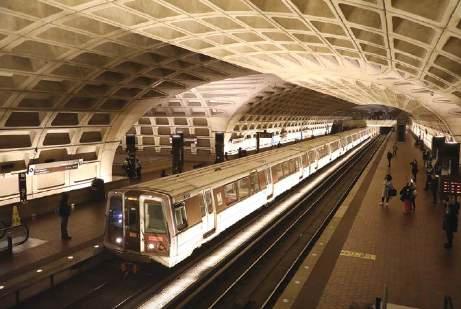

andrew thompson uncovers how a series of extensions and new lines in this italian city will help manage demand not only from the resident population, but also from the regular influx of tourists.
In late January 2025 the newest addition to the growing tramway network of Florence (Firenze) was opened. As the regional capital of Tuscany (Toscana), Florence has an urban population of roughly 380 000, with up to one million in the greater metropolitan area. As a widely-popular tourist destination, the city sees a significant influx of visitors throughout the year, creating additional demand for sustainable mobility solutions and efficient public transportation.
With the recent extension of tram line T2 by 2.5km (1.6 miles) from Fortezza via Liberta’ Parterre to San Marco-Università, the Florence network is currently about 19km (12 miles) long. The new terminus at the university is located in an attractively rebuilt square in the historic old town, just 500m from Piazza del Duomo and the famous cathedral dating from the 15th Century. The new route includes six additional stops and – due to narrow streets and historic premises – uses a large singletrack loop at the end of the line, serving three separate stops.
Taking the tramway into the old town originally faced fierce public opposition, so the current route variant was developed as a political compromise. It is therefore not planned to build any other light rail
routes into the UNESCO-designated World Heritage zone.
Near Piazza della Libertà and along Viale Giacomo Matteotti, points and tracks have already been laid for the T3 project and a future extension further southeast to Bagno a Ripoli. This major extension will be roughly 7.2km (4.5 miles) long and feature 17 new stations, plus bring the construction of a second depot to support the future fleet necessary for the running of the larger network. Part of the C-shaped T3 route alignment will be fitted without catenary, for aesthetic reasons. The other terminus of
line T3 will be at Rovezzano at the namesake Firenze Rovezzano railway station on the main line east of the city centre. In a best-case scenario, a first section of line T3 could be completed by late 2026. As a result of the T2 extension, the line’s former terminus in the form of the short track stub at Unita, opposite the main railway station Firenze Santa Maria Novella, has been relegated to occasional use only for operational purposes and is not served by either lines T1 or T2. These instead call across the street at Valfonda-Stazione SMN.
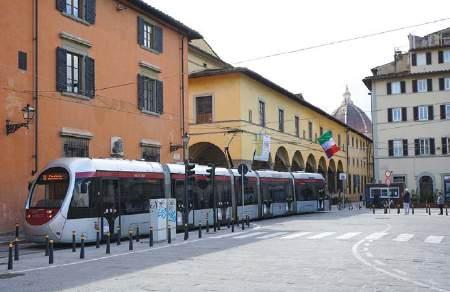
T2 extension to Sesto Fiorentino
Peretola Aeroporto
T2
Guidoni
Novoli –Palazzi Rossi
Novoli – Torre degli Agli
Novoli – Regione Toscana
San Donato – Università
T1
Careggi – Ospedale
Vittorio Emanuele II
Dalmazia Pisacane
Buonsignori – Liceo Da Vinci
Ponte all’Asse
Belfiore
Rosselli
Redi
Poggetto
Leopoldo
Lavagnini –Poliziano 1 2 3 4
Cavour
Sansovino
Batoni Talenti
Federiga
Arcipressi
2 0 1
Kilometres
STOPS NEAR CENTRE 1. Lavagnini – Fortezza 2. Strozzi – Fallaci 3 & 4. Statuto
Libertà Parterre
La Mormora Orto Botanico
Cascine Paolo Uccello
Porta al Prato –Leopolda
Alamanni –Stazione Unità Valfonda Fortezza San Marco – Università

Aldo Moro
De André Villa Costanza
Resistenza
Nenni – Torregalli
“The new route includes six additional stops and – due to narrow streets and historic premises – uses a large single-track loop at the end of the line.”

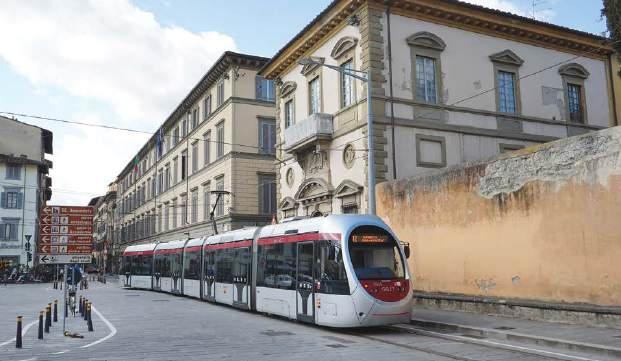
Florence originally featured a firstgeneration tramway from 1879 to 1958. After many years of deliberations and planning, a modern second-generation tramway opened in 2010 with the original section of line T1 running for a distance of 7.4km (4.6 miles) from Alamanni-Stazione to Villa Costanza in the neighbouring commune of Scandicci, west of the city centre. Later, in July 2018, line T1 was extended by 4.1km (2.5 miles) further north from Alamanni-Stazione to the medical complex at Careggi-Ospedale.
The first 5.3km (3.3-mile) section of Line T2 from Unità to Peretola-Aeroporto opened less than a year later in February 2019, providing a vital link between the airport, a sub-campus of the university and the main railway station.
Currently Florence features a fleet of 46 double-ended Hitachi Sirio. Originally this design had been developed by AnsaldoBreda, but was later taken over by the Japanese company, together with AnsaldoBreda’s entire railway portfolio. In summer 2024 it was announced that Hitachi had won the contract to supply another 46 Sirio trams for the future lines T3 and T4. These vehicles will include traction batteries for use on purposefully nonelectrified sections. Deliveries are expected to commence in 2026.
top left: as Sirio 2035 turns left at the circular piazza della liberta’, to the right the points that have been installed for the future t3 are visible. the points turn into Viale Don giovanni Minzoni, where the first 140m of track is already in place leading towards the future rovezzano terminus.
left: running on the single-track loop at the end of t2, Sirio 2018 arrives at piazza San Marco, the new terminus of the line in the heart of the old town.





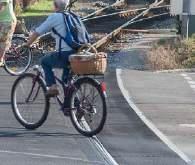

















Andrew thompson explores a german system with a slightly different distinction, which has recently opened a new southern route and is looking forward to further extensions, a new fleet and new depot.
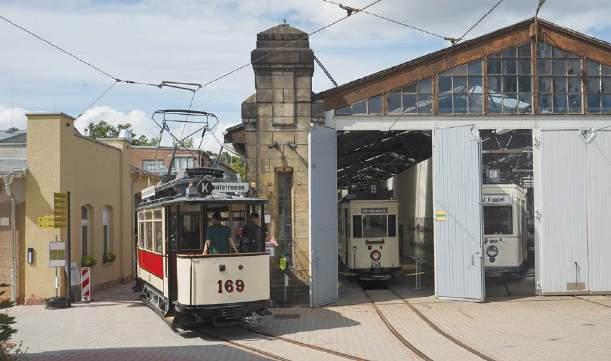
Chemnitz is one of the roughly half-dozen German cities with a tram-train network. Unlike similar systems in Karlsruhe, Saarbrücken or Kassel, the so-called ‘Chemnitzer Modell’ is distinctive in that it makes use of diesel-electric bi-mode vehicles. Therefore the tram-train LRVs use their auxiliary diesel engines on the non-electrified overland routes that are part of the main line railway infrastructure maintained by DB InfraGO, such as to Aue (Erzgebrige), Hainichen, Mittweida or Burgstädt. Only the north-south line to Stollberg (Erzgebirge) is electrified, and incidentally this was also the pilot line of the tram-train system, opening for revenue
leFt: the only bit of 3ft-gauge left in chemnitz today is about 100m of line at the tram museum in the west of the city, which can be reached via tram line 1 and the stop at Am Feldschlösschen. the classic depot dates from 1908 and houses a number of preserved heritage cars from different epochs. Open-balconied motor car 169 from 1919 is seen during a private demonstration run for a group of TAUT readers on a trip organised by the Railway touring company in early June.
BelOW: In the late 19th and early 20th century, chemnitz was known as a major manufacturing centre, both for mechanical engineering and textiles. not surprisingly, much of the city's industry was targeted during World War two and a significant part of the historic architecture was lost to aerial bombardment. therefore the city was rebuilt in a socialist style in the 1950s and 1960s, and only pockets of old buildings and individual landmarks still exist. Dating from the end of the 12th century (albeit rebuilt in the 1950s), the stone tower Roter turm is one of these iconic buildings, and on 6 June provides the fitting backdrop for Škoda ForCity 918. to the rear is the galerie Roter turm shopping centre.
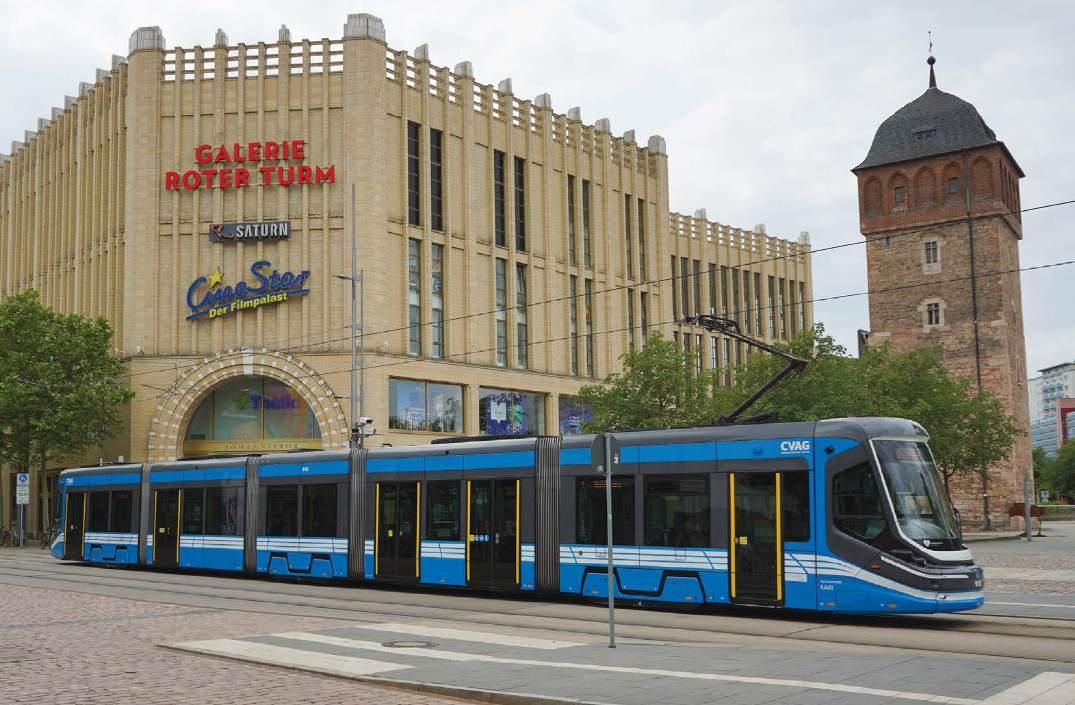
Schőnau
Marianne-Brandt-Strasse
Kappler Drehe
Am Feldschlősschen
Guerickestrasse/ Messe Chemnitz
Dr.-SalvadorAllende-Strasse
Sűdring
Heiterer Blick
Morgenleite
JohannRichter-Strasse
To Burgstädt
To Mittweida To Hainichen
Omnibusbahnhof
Theaterplatz
Brückenstrasse/Freie Presse Moritzhof
Roter Turm
Zentralhaltestelle
Falkeplatz/Museum Gunzenhauser
Bahnhof Mitte/ Niklasberg
Reichsstr.
Parkstr.
Haydnstr. Goethe platz.
Irkutsker Strasse
Am Flughafen
Ikarus
Chemnitz Hauptbahnhof Hbf. Bahnhofstr.
Stefan-Heym-Platz
Annenplatz Bahnhofstr.
Treffurthstrasse
Rößlerstr.
Erdmannsdorfer Strasse
Uhlestrasse
Dittersdorfer Strasse RobertSiewert-Str.
Markersdorfer Strasse
VITACENTER
Ernst-Wabra-Strasse
Hutholz
services in December 2002. Since then the system has continuously grown and is still set to expand in the coming years. Most recently, the long southern route to Aue was integrated in early 2022 after three years of adaptation works, including a new link and transfer point between the urban tram network and the overland route at Chemnitz Technopark. The other main boundary point between the traditional tram network and the overland routes is at Chemnitz Hauptbahnhof and at Altchemnitz for line C11 to Stollberg. Branded as City-Bahn Chemnitz, the four tram-train routes run with the prefix C and also feature a prominent red C-shaped logo. The backbone of the fleet are 12 bi-mode Citylink, which were delivered by Vossloh and then Stadler in two series of 8+4 starting in 2015. These three-part, low-floor LRVs are 37m long and feature a toilet cabin, which is locked out of use when the vehicles pass through the city centre, so as to prevent abuse. In March 2022, the regional public transport authority Verkehrsverbund
Reinecker strasse Nürnberger Strasse Gablenzplatz
Zieschestr./ Schauspielhaus Tschaikowskistrasse
Annenstrasse Bernsbachplatz
GustavFreytagStr.
Stadlerplatz
Rosenbergstrasse
Lutherstrasse
Gutenbergstrasse Wartburgstrasse
TU Campus
Technopark
Schule Altchemnitz Scheffelstrasse
Alt Chemnitz Center
Schneeberger Strasse
Altchemnitz
Bernsdorf

Arthur-Strobel-Strasse
Gablenz
Augsburger Str.
Pappelhain
Mittelsachsen (VMS) announced the procurement of another 19+22 optional Citylink from Stadler for the planned northern and southern extensions of the system in the coming years.
To house this new fleet, a purpose-built depot is to be constructed at Sachsen-Allee near Hauptbahnhof, giving the LRVs easy access to both the light rail and main line networks. As part of this project, a feasibility study for a new tram line to the football stadium and the Zeisigwald district of Chemnitz is also being conducted.
Generally the next expansion stages of the tram-train system should take the City-Bahn north to the historic Kasberg district of Chemnitz at the interim terminus Leipziger Strasse, and then in the next stage to the neighbouring commune of LimbachOberfrohna, to the northwest. As part of this tram-train expansion by 2030, the conventional tram network is also set to grow with the addition of an outer ring route to the north of the city centre, including
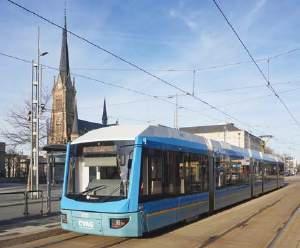
ABOVe: the single-ended Variobahn lRVs were the first low-floor cars delivered to chemnitz in the 1990s. the prototype made trial runs here in 1993, with more series cars being supplied from 1998 to 2001. the total fleet consists of 13 single-ended vehicles and ten double-ended variants. the blue single-ended cars are only used on the urban tram network, while the red double-ended lRVs are suitable for deployment on tram-train route c11 to Stollberg. cVAg single-ended car 610 calls at theraterplatz in the city centre, while on a line 4 service to hutholz.
stops at Stadthalle, Innere Klosterstrasse and Getreidemarkt.
At the southern end of the tram-train network, the project to build a 3.5km (2.2-mile) new route from the current Stollberg station terminus via the town centre and Stollberger Tor to the junction of the main line railway at St. Egidien is at an advanced stage of planning after years of feasibility studies. With financing in place, a best-case scenario would see preparatory construction works start in early 2026, with completion and inauguration foreseen by 2029. Currently the Stollberg branch is served by six double-ended type NGT6-LDZ Variobahn LRVs. Once the new route through to St. Egidien is open, it will make direct train travel from St. Egidien to Chemnitz possible at last, eliminating the need for interchange and marking a step-change in service quality for commuters.
The conventional tram network in Chemnitz first opened in April 1880 and had the unusual gauge of 3ft (914mm), thus making it the narrowest in Germany. The British gauge was chosen as the English engineer W. Roebuck had been granted the royal concession to build and operate the horse tramway. By May 1892 the horse tramway had grown to a length of 7.15km (4.4 miles), marking its greatest extent.
Electrification was implemented the following year and public electric services commenced in December 1893. Because the non-standard gauge proved impractical and made it difficult to procure rolling stock, efforts to convert the Chemnitz system to 1435mm standard-gauge emerged in the early 20th Century, but proved too complex and costly to implement. The previously private tramway company was taken over by the city authorities in 1908 and from then on, when tracks were renewed, 925mm-gauge replacements were installed instead. The last 925mm-gauge tracks would last until 1988, after a full-blown standard-gauge conversion programme commenced in summer 1958.
As Chemnitz was behind the Iron Curtain in the Russian-controlled zone that became the socialist German Democratic Republic in 1949, the city was renamed Karl-Marx-
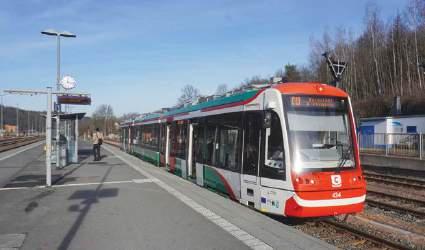
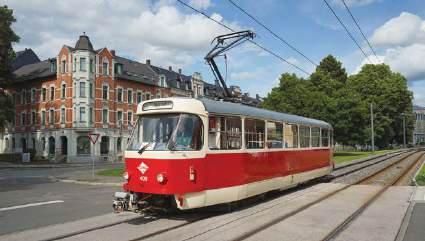
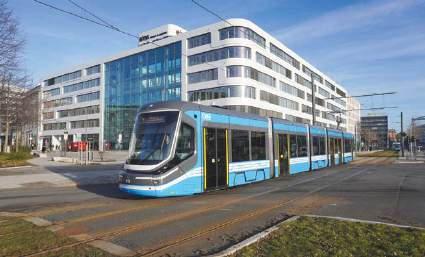
Stadt in 1953, on the 70th anniversary of Karl Marx’s death. After the fall of the Berlin Wall and German reunification, 76% of city residents voted to restore the historic city name in a referendum in April 1990.
Through the ambitious gauge conversion programme, the map of the Chemnitz tramway was significantly altered as well, as some routes were closed, others realigned, and some new lines built. As was typical in East Germany, a priority was placed in linking up the residential districts on
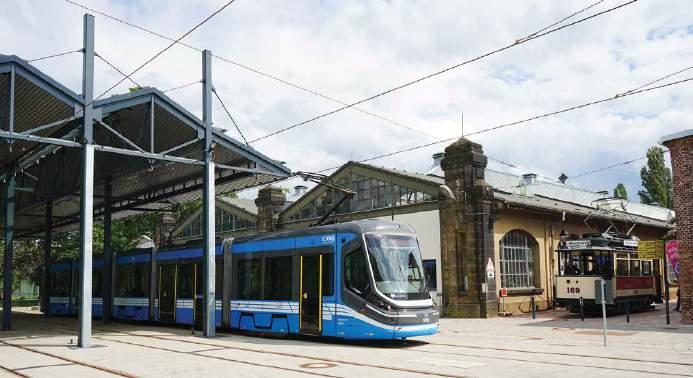
leFt: Running in diesel mode on the overland route c13, Citylink 434 has arrived at the Aue (erzgebirge) terminus, which is also served by DB trains to zwickau and Johanngeorgenstadt on the czech border.
leFt: car 409 is one of the preserved tatra T3D trams. It carries its original livery and is used for touristic sightseeing tours of chemnitz. On 6 June 2025 it is on the eastern branch of line 5 to gablenz.
leFt: In 2025, chemnitz has the honour of having been designated a european capital of culture by the eU. this distinction and associated programme of events has brought additional guests and visitors to the city, thus boosting public transport utilisation. On 20 January, Škoda 913 is seen on the approach to the zentralhaltestelle main interchange in the city centre.
the periphery of the city with their blocks of flats. Today these routes are served by lines 4 and 5 running southwest to Hutholz. Another landmark moment in the tramway’s rolling modernisation occurred in February 1969, when the first Czech-built Tatra T3D arrived and were deployed on the new standard-gauge routes. To extend their service lives, some of the T3 vehicles received major overhauls in Bautzen in 1992-93, replete with a modified appearance and new light blue livery. Reclassified as T3D-M they would continue in service until 2019-20, when they were replaced by the 14 doubleended Škoda type 35T ForCity
On the infrastructure front, the most recent 21st Century tram network extensions were the construction of the full tram loop at Hauptbahnhof in 2013-14 and the new 1.5km (0.9-mile) line from Stadlerplatz to Technopark in December 2017, as part of the planned integration of the overland line to Aue into the tram-train network. Thus the current size of the urban tram network, without the overland tram-train sections, is about 34km (21 miles).
With a population of roughly 246 000, Chemnitz is a mid-sized city that benefits from a modern and innovative public transport system that serves the conurbation well and is set to grow to provide even greater connectivity. The tram-train network was always conceived for modular development and growth in line with demand.
Le Mans is associated with the world’s most famous high-speed road race, but daily life relates more to a public transport network with an 18.8km (11.8-mile) tramway at its core.
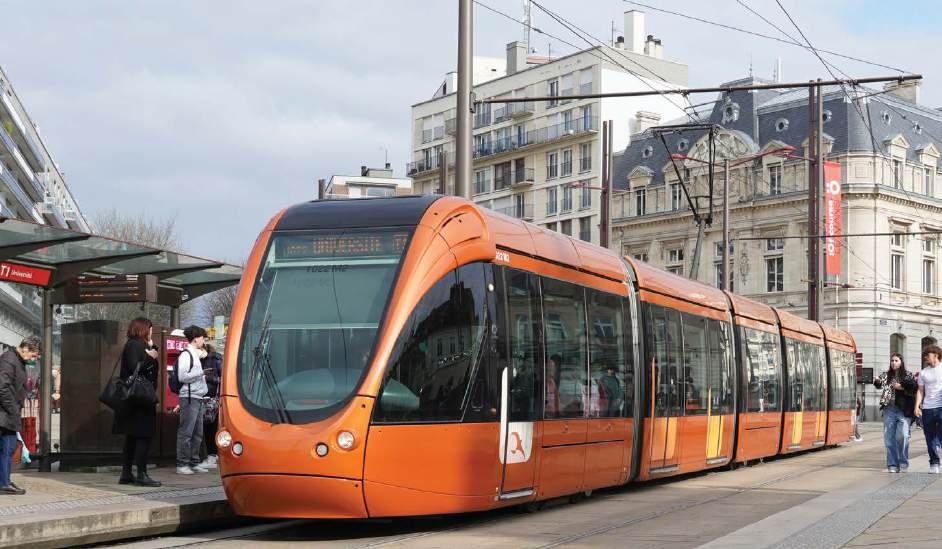
The capital of Sarthe department in Pays de la Loire region, Le Mans is 185km (116 miles) south-west of Paris. Le Mans became a western terminus of the LGV Atlantique line in September 1989, with SNCF TGV trains now taking about an hour between Le Mans and Paris Montparnasse. With approximately 145 000 residents, Le Mans is the most populous commune amongst the 20 now making up Le Mans Métropole, population 214 000. The main employers are insurers Covéa MMA and the Renault group, with health care and education also important. Arrival of railways in the mid-19th century rapidly increased Le Mans’ population. The industry remains significant, with the city still at a convergence of lines and having a rail maintenance centre.
The public transport network is branded and styled as SETRAM (Société des Transports en commun de l’Agglomération Mancelle), the
acronym only by coincidence containing the word tram. Unrelated to an Algerian transport body with the same title, the Le Mans Setram was established in 1974. This was around 27 years after the metre-gauge city tramway and mainly rural ‘Tramways de la Sarthe’ closed, and 38 years before today’s system opened. Trolleybus coverage of former city trams lines ended in 1969. In addition to the current two lines, Setram has 28 normal bus lines and runs school services, as well as cycle hire and parking sites. Setram is an arm of the metropole with which Keolis is contracted for technical aspects: a new contract term is due to start in January 2026.
The identity of Le Mans is dominated by the annual 24-hour motor race, with victory based upon the distance covered. First staged in 1923, the 24 Heures du Mans is usually held each June. It attracts more than a quarter-
million visitors, with about threequarters of the city’s yearly tourist revenues being generated around this time. Mainly on temporarily closed public roads, the 13.6km (8.1-mile) Circuit de la Sarthe borders the southern part of the urban spread. On 19 November 2007 this area welcomed the much slower but more capacious vehicles of a new Le Mans tramway. With infrastructure construction between 2004 and 2007, the system opened with 12.8km (eight miles) with 24 stops running north-west from a southern terminus at Antarés MM Arena. Soon after leaving here, the tracks pass beneath a securityfenced road, part of the circuit at the northern end of the famed Mulsanne straight. Track then loops around Setram’s Hunaudières depot site and operational centre which has a staffonly halt. The approximate 1.6km (one mile) between Antarés MM Arena and the next public stop, GuetteloupPôle Santé Sud, represents the system’s longest wholly-separate right of way.

ABOVE: Pont Gambetta over the Sarthe river, with the ridge including the historic Cité Plantagenêt area in the background.
RIGHT: Emerging from beneath barrier-like buildings, 1005 approaches line 2’s main central stop, Comtes du MaineOffice du Tourisme.

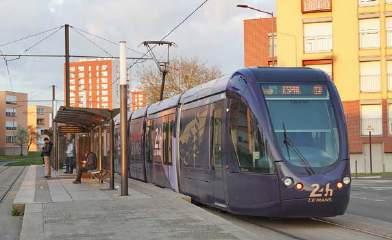
The 34 bi-directional Alstom Citadis 302 trams assembled in Aytré (La Rochelle) are numbered 1001-1034. The initial batch of 23 was supplemented by three in 2011. The remainder from 2013 were required for the service’s expansion. In original form, all have five fully low-floor sections over 32.7 metres and are 2.4 metres wide; capacity 163 standing and 48 seated. Information screens
include interchanges with other Setram lines at each stop. The majority of trams carry names of the area’s communes, with other local references including Plantagenêt, Wilbur Wright (for his flights at Hunaudières race course in 1908), Arche de la nature and sports teams MSB and Le Mans FC The main livery colour described by designers RCP as ‘red tobacco’ has additions of the metropole’s
Most of the remainder is road-based, either in space between carriageways or on-street; some areas featuring traffic restrictions. After passing access roads to the city’s southern by-pass, a near-straight 3.5km (2.2 miles) of track ends with a westward turn to run parallel with a main line embankment. Running through the main station’s forecourt, tram tracks soon rise on approach to the main square, Place de la République. From this high point comes a descent to cross the Sarthe river, then a lengthy on-street climb before the lines returns to dedicated space. After passing the hospital site, tracks weave around the university campus, ending at Université terminus. About a month after this route opened, a 2.6km (1.6-mile) southern branch was added. It extended east from Saint Martin, a busy tram-bus interchange just north of the Huisne river, crossing the Sablons-Bords de l’Huisne district. This was one of the five in Le Mans classified as a priority urban neighbourhood. The branch ends at Espal-Arche de la Nature, the latter part of the stop’s name referring to a nearby conservation park. Until restructured in 2014, all tram services were designated as line 1, but differentiated according to their southern termini.
LEFT: Line 2’s southern branch is characterised by a concentration of public housing: this is Churchill stop in Sablons, an area designated as a priority urban neighbourhood.
bird emblem and small yellow and orange panels; seating also uses the red-orange colour. In April 2023, eight trams received mainly dark blue and red liveries with images to commemorate the 24-hour race’s 1923 inauguration. The styled ‘: Of Course’ shown with this livery is identified by the originating agency as a ‘communication brand of the city of Le Mans’ as adopted in 2019.
The system was identified at its opening as having the lowest cost per kilometre amongst the new French tramways. The main change since 2007 has been the addition of an approximately 4km (2.5-mile) north-eastern arm with six new stops in September 2014. The Sablons branch included areas deemed to need better transport access and environmental improvements. The new route extended from a junction – not installed with the original line –on Place Aristide Briand which is just north of Préfecture stop. From here trams pass beneath a multi-storey building, part of the architecturally brutal surroundings of the busy Comtes du Maine-Office du Tourisme stop. After passing newer yet similarly stark structures, the line enters more spacious surroundings at Place Des Jacobins which is overlooked by Saint Julian of Le Mans cathedral. Grassed track along road centres climbs through mixed residential areas to Bellevue-Hauts de Coulaines terminus. With the new branch came the introduction of separate lines T1 and T2. As per the original opening, T1 ran specifically between Université and Antarés MM Arena, with services scheduled for 39 minutes between termini. The new T2 took over the Espal-Arche de la Nature branch and the newer counterpart to BellevueHauts de Coulaines, timetabled for 29 minutes. The overlap of both lines including seven stops between Saint Martin and Préfecture can bring
Cadran – Épine
Université T1
CampusRibay Haute
Venelle –Clinique du Pré
Bellevue – Hauts de Coulaines
Hôpital Théodore Monod
Gambetta – Mûriers
“the system was identified at its opening as having the lowest cost per kilometre amongst the new french tramways.”

Lafayette
Éperon-Cité Plantagenêt République
Maillets – Zammenhof
Maillets – Banjan
Croix de Pierre
Jacobins – Quinconces
Comtes du Maine – Office de Tourisme
Préfecture
Leclerc – Fleurus
Gares Zola Viaducs
Jaurès – Pavillon
Saint Martin
Pontlieue
Atlantides –Sablons
Churchill
Epau – Gué Bernisson Espal – Arche de la Nature
Île aux Sports
Goya
Durand – Vaillant
Jules Raimu
Glonnières – Centre Sud
Guetteloup – Pôle Santé Sud
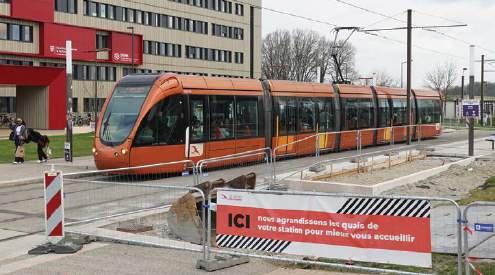
Antarès-Stade Marie Marvingt
BELOW: Having left Antarés MM Arena, 1018 descends towards the underpass taking the
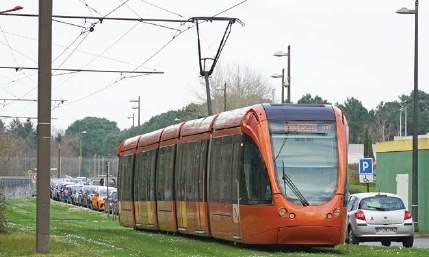
“the capacity shortfall is being addressed by extending each tram from five to seven sections, representing a 40% capacity increase.”
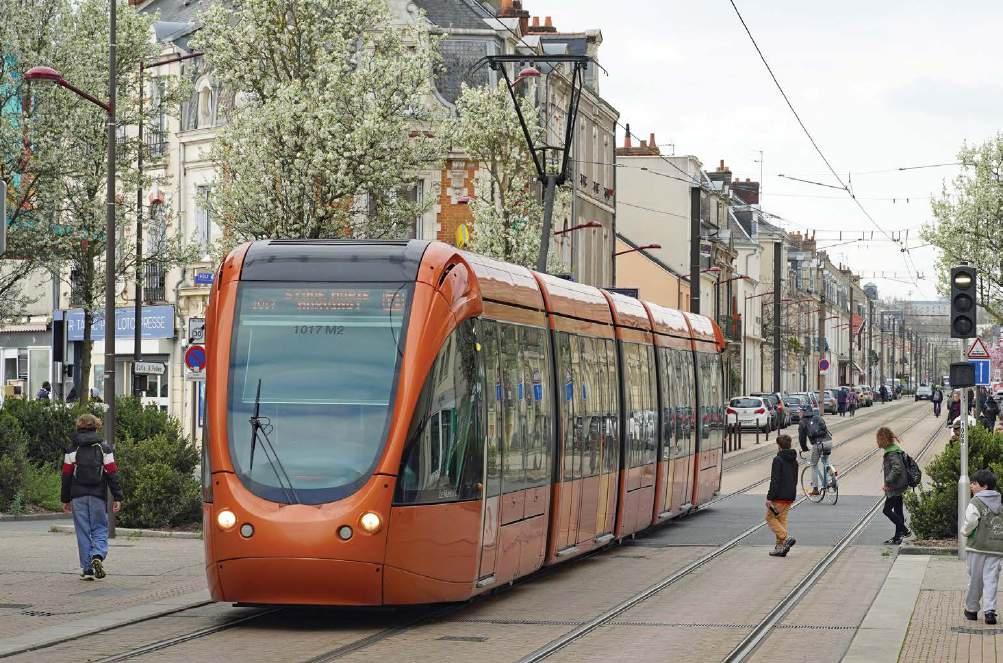
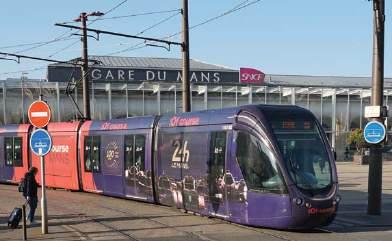
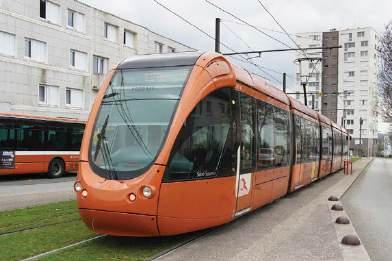
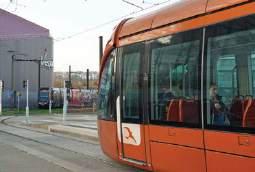
ABOVE: Initially designated as part of line 1, system expansion led to Espal-Arche de la Nature becoming the southern terminus of the new line 2.
ABOVE LEFT: At the south of the central area, the main station, Gare du Mans, is the city’s principal public transport interchange.
RIGHT: An Iveco Crealis 18M with a T3 service at the Gares departure platform: the Tempo sub-branding distinguishes this format from other Setram buses.
BELOW: Southbound 1017 descends towards the Sarthe on shared space along Rue
Opened: 2007
l ines: 2
stops: 35
Depots: 1 approx. weekday hours: 05.30-00.00
m ain line frequency: T1 5-6 minutes; T2 6-9 minutes
Gauge: 1435 mm
Power: 750V dc, overhead supply fleet: 34
c ity network/operator: Setram www.setram.fr
Regional rail (te R aléop): www.ter.sncf.com/pays-de-la-loire
c ivic information: www.lemans.fr and www.lemansmetropole.fr tourist information: www.lemans-tourisme.com
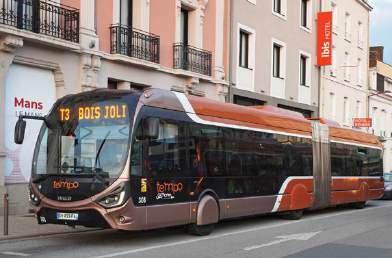
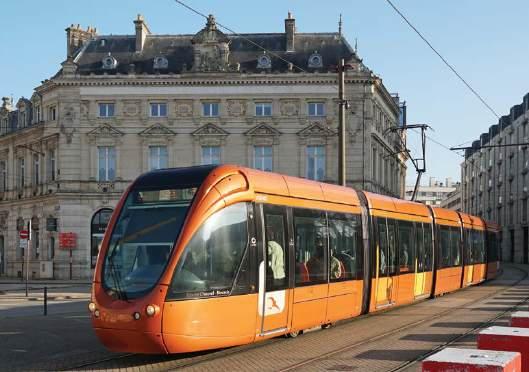
a central frequency of just three minutes. This includes coverage of the city’s principal public transport interchange which is centred upon the main station, Gare du Mans. The tram stop adjoining the station is named Gares, the plural being due to the adjoining Gare routière (long distance and regional) bus station. City buses are also present here, as is Setram’s T3. Although designated T3, this BHNS (high-level bus service) was introduced in 2016. It uses ten articulated 18-metre Iveco Crealis vehicles, each with approximately half the capacity of Le Mans’ current Citadis trams. Mainly with a 7-9 minute weekday interval, Tempobranded T3 runs partly in reserved bus lanes and with traffic light priority for
7.2km (4.5 miles) between the southwestern Allonnes commune and the main station’s forecourt. Titled Gare du Mans-Hôpital-Université and sited next to the T1 Hôpital stop, a TER regional station opened in August 2023. This brought better access to major employment sites in the northwest, for many also avoiding transfers at the main Gare du Mans.
Although passenger numbers have still not recovered to pre-pandemic levels, heavy tram loadings – not confined to the normal peaks – are very apparent. There is little scope for increasing frequencies on the central section, which hosts both lines, without causing other traffic problems. The capacity shortfall is being addressed by extending each
The Le mans tramway was one of the first tram designs created by RCP Design Global. The project marked a significant milestone for the French agency, which has gone on to design 15 tram systems across France and internationally.
Building on 20 years of experience, RCP continues to pioneer new approaches to design, with a clear focus on mobility, movement comfort and an innovative application of sensory design — a distinctive expertise that sets the agency apart. Its mission: to create transport experiences that are not only functional but intuitive and engaging. Among RCP's latest innovations are solutions aimed at improving passenger flow, such as the integration of lighting and smart-lighting systems, notably on the Paris-Orly T9 line, and the ergonomic design of standing travel zones, as seen in the latest-generation trams in Nantes.
The agency also places a strong emphasis on inclusivity. Current projects, such as the tramway in Grenoble, prioritise accessibility for all, with careful attention paid to signage, doorway design and surface finishes, as it did in Tours, where innovative finishes enhance both function and aesthetics. RCP's work extends to encompass the design of the
LEFT: The junction for lines 1 and 2 near Préfecture stop.
RIGHT: Running parallel to the main line west of the main station, 1024 from the second fleet batch near Viaducs stop. The Dominique Niederkom name honours a local politician who died in 2009, a strong supporter of the tramway project.
RIGHT: Université terminus on 26 March 2025: the bus replacement sign relates to the off-peak closures needed for the platform lengthening works.
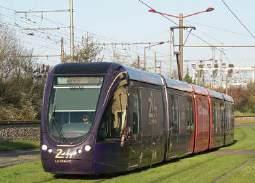
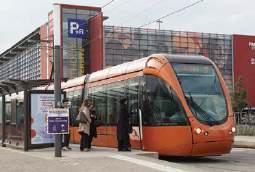
entire passenger journey. Its approach to intermodality focuses on ensuring a coherent and attractive transport network. Examples include wayfinding and transition furniture currently being developed for the Lille Metropolis, and infrastructure design for the Vélo Île-de-France cycling network, where user-friendly paths are contributing to a more seamless urban mobility system. This human-centered approach earned RCP the 2024 Janus de la Cité award for its contribution to the Nantes tramway, recognition of its commitment to enhancing the quality, accessibility and experience of public transport through thoughtful, forward-thinking design.
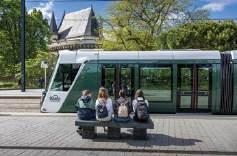
tram from five to seven sections, representing a 40% capacity increase. Incorporating upgrades to on-board information and surveillance, as well as noise reduction measures, the work will be carried out at the system’s depot. With the work contracted to Alstom, the target for receiving the first of the extended trams is March 2026, with revenue services beginning that summer. The depot is being modified to deliver the project and to store the future 44-metre vehicles. Platform extensions have been needed at 22 stops. There are designated parkand-ride sites at the two tram line 1 termini. Antarés MM Arena is officially recommended for spectator access to the 24-hour and other races, during which timetables may be amended. There are no planned tramway extensions, although the Tempo-style format used on T3 is due with the upgrading of three conventional bus routes.
local travel: Staffed Setram information office at 65 Avenue du Général de Gaulle, equidistant between T1 République and T2 Comtes du Maine-Office du Tourisme. The print ‘Plan de Lignes’ is recommended for network and related visitor information; separate timetable leaflets. Ticket machines including an English language option at all stops. On-board ticket validators; validation for each boarding required. Covering bus and trams and allowing for transfers after initial validation, single one-hour ticket for EUR1.50; ‘1 Journée’ for 24 hours, EUR4.20. The designated P+R sites at the two tram line 1 termini charge EUR3.50 which includes day tickets for the vehicle occupants. What is there to see? Main tourist office at 16 Rue de l’Étoile; walk north from Comtes du Maine-Office du Tourisme stop. Beyond the appeal for motor racing enthusiasts including a museum (www.lemans-musee24h.com), the core Le Mans attraction is an historic quarter. Including remains of Roman walls and a maze of narrow streets, it stretches south-west along a ridge parallel to the Sarthe. At the eastern end is the Saint Julien cathedral which, reflecting its long history, integrates several architectural styles (T2 Jacobins-Quinconces). A southern access to the area is from the T1 stop Éperon-Cité Plantagenêt. The tram cities of Tours and Angers are around one hour away by regional train, with Nantes taking from 80 minutes.
INDUSTRY. Keolis is paying Downer EDI AUD132m (EUR74m) to buy out its 49% stake in the joint venture that has run for 15 years. Downer will continue to operate its rolling stock maintenance business. IRJ
AUSTRIA
WIEN (Vienna). Opening of two tramways is to take place on 1 September; line 12 from Rebhanngasse to Hillerstrasse and line 27 from Prinzgasse to Aspern Nord (Nelson-Mandela-Platz).
Alstom Flexity vehicles 411 and 412 were delivered at the end of June, followed by 413 and 414 in July. tramwayforum.at WIEN – BADEN (WLB).
Tram services in Baden were to terminate at Landesklinikum 4-31 August to permit infrastructure modernisation between there and Josefsplatz. tramwayforum.at
ANTWERPEN (Antwerp).
Tram 7262, the first refurbished Hermelijn, returned from CAF on 27 May. Made-over trams can be distinguished externally by their LED headlights.
New CAF trams were to enter service on lines 3 and 5 in September. T-2000
BRUSSEL/BRUXELLES
(Brussels). Signals in the Montgomery subway have been adapted to permit two eight-axle trams to be present at the same time. This is in preparation for the introduction of 21 7900-series trams on lines 39 and 44.
The new Flemish government halted the project to extend the tramway to the airport on 4 June.
T-2000
GENT (Ghent). Hermelijn 6301 has become the first of the type to return after refurbishment by CAF in Spain.
PCC 6240 has been scrapped.
KNOKKE – DE PANNE (De Lijn). A total of seven trams from Antwerpen (Antwerp) and Gent (Ghent) will be used to boost service on the coastal tramway in July and August. BS
SARAJEVO. Replica 1895 twoaxle tram 15 returned to service on 19 July. It runs between the railway station and Baš č aršija MondayFriday and weekends.
Vlada Kantona Sarajevo BRAZIL
SÃO PAULO. Alstom delivered the first of 22 metro trains for line 6 (due to open late 2026) on 8 July. skyscrapercity
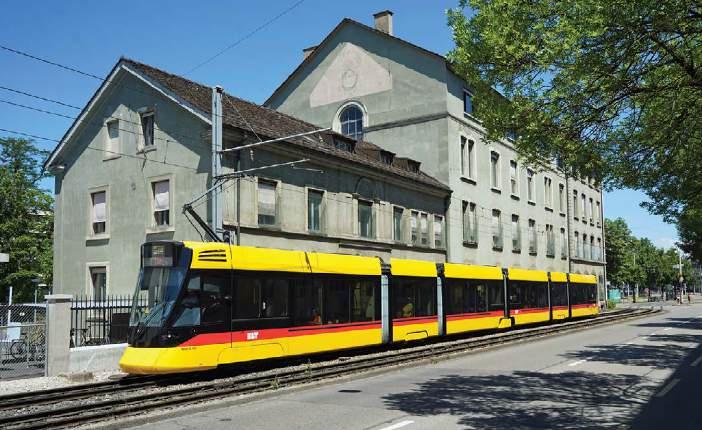
MONTREAL. The private REM metro line closed on 5 July to permit dynamic testing on its north and west extensions. Replacement shuttle buses were to run until 17 August, while the extensions are expected to open in October. La Presse QUEBEC. The former Bombardier factory in La Pocatière, north-east of Quebec City, is to build the 34 Citadis trams ordered in 2023. cimtchau.ca
VANCOUVER. The first of the Expo Line’s 47 Alstom Mark V automated five-car light metro trains entered service on 10 July. The whole fleet is to be operational by 2029. They are to offer a 25% increase in capacity over the Mark I trains they replace. I. Fisher
CHONGQING. Passenger service on metro line 6’s 6.9km (4.3-mile) branch from Liujiaping to Chongqingdong Railway Station started on 27 June. urbanrail.net
GUANGZHOU. New metro lines 10 and 12 opened on 29 June. Line 10 links Xilang and Yangji East, while the 37.6km (23-mile) line 12 runs from Xunfenggang to High Education Mega Center South. urbanrail.net
NANCHANG. Metro line 1 was extended from Shuanggang to Changbei Airport on 28 June; on the same day, metro line 2 was extended from Xinjia’an to Nanchang East Railway Station. urbanrail.net
NINGBO. The new 21.8km (14-mile) metro line 8 (Kaiyuan Road – Hansong Lu) was opened
on 30 June. A further one-station extension to Xiaying Nan is under construction. urbanrail.net
SHAOXING. Line 1’s branch was extended by 3.2km (two miles) from Daqingsi to Huizhan Zhongxin (Exhibition and Convention Centre) on 30 June. This is to become part of line 4. CNGL
SHENYANG. Metro line 1’s 16km (ten-mile) Limingguangchang –Shuangma extension opened on 30 June. urbanrail.net
SHENZHEN. A joint trial with chain store 7-Eleven is underway: 36 robots are using the metro in order to restock stores at stations during off-peak hours.
TIANJIN. The Xizhan – Xiaojie section of metro line 4 was opened on 8 July. The 19.9km (12-mile) line has 16 stations. urbanrail.net.
BOGOTÁ. The ground-breaking ceremony for the 39.6km (25-mile) Western RegioTram took place on 18 June. China Civil Engineering Construction Corporation is building the COP2.9trn (EUR606m) project and the first section should open in late 2027. It is planned to use 18 CRRC-built LRVs. UTM
BRNO. Line 8’s new Škoda 45T trams 1770-72 arrived in June, following May’s delivery of 1765-69.
BS PLZEŇ. Škoda has delivered new 40T trams 403-406. BS PRAHA (Prague). DPP is to equip 123 Škoda 15T trams with air-conditioning, at a cost of CZK431.5m (EUR17.6m).
Tatra T3s 5520 and 7122 have been sent to Brno for refurbishment; 5520 is to receive its original number 6312 before its eventual return to service on line 23. High temperatures have been blamed for a city-wide power outage that stopped all public transport around mid-day on 4 July. Metro operation resumed at 12.35, trams at around 14.30. praguemorning.cz
KØBENHAVN (Copenhagen). A tender has been issued for the operation and maintenance of the automated metro. The existing contract expires on 28 September 2027. IRJ
ANGERS. RATP Dev has retained the contract to operate tram and bus services from 2026 to 2031. RGI BREST. The first of the eight new Alstom Citadis trams is to be delivered in September. It is to enter service in February 2026. lineoz.net MARSEILLE. The 6.2km (fourmile) extension to T3 is to open in November. In anticipation, CAF delivered the first of 15 new 100% low-floor 42.5m Urbos in July. Designed to carry 262 passengers (62 seated), its exterior design is based on the existing Bombardierbuilt trams. UTM MONACO. SYSTRA France has been appointed to provide technical advice for the design and implementation of a cross-border metro between Monaco and France. Dubbed ‘Operation La Brasca’, the automated underground metro is to link the principality with a new park-and-ride facility at La Brasca,
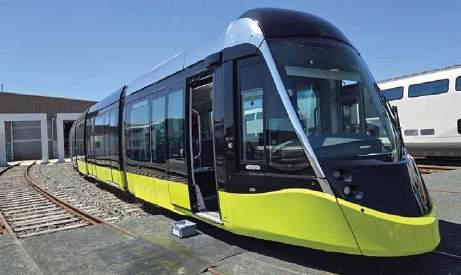
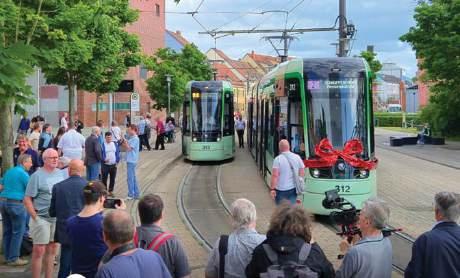
between the French municipalities of Èze and La Turbie, and the Monaco border.
MONTPELLIER. Line 5’s last rails were welded on 10 July. It is due to open on 20 December.
Tenders have been invited for the project management of the Jeune Parque depot extension. A new workshop is to be built, along with enough track to cater for 14 43.7m trams. lineoz.net
ROUEN. The council agreed on 30 June to carry out studies on possible tramway extensions in order to replace the TEOR bus rapid transit lines. lineoz.net
STRASBOURG. Cross-border services to Kehl ceased from 28 July to permit infrastructure work on the German part of the line. They are to resume from 22 August.
Tram Line F’s Koenigshoffen –Wolfisheim extension is to open on 15 November. urbanrail.net
TBILISI. An order has been placed with GT Group for 25 new metro trains, to be built by CRRC. The new fleet comprises 14 four-car and 11 five-car trains. skyscrapercity
BERLIN. Demolition of the road viaduct at Treskowallee/ Edisonstrasse permitted the resumption of tram service across the junction from 31 May.
Opening of City S-Bahn line S15 has been postponed again, this time to early 2026. BS BOCHUM-GELSENKIRCHEN. Withdrawal of Stadtbahn-M 311 on 18 June marked the end of the class. However, 332 has been preserved. BS COTTBUS. New Škoda 43.5m low-floor trams were to enter service in late July.
KTNF6 150 has been scrapped following an accident. BS DRESDEN. NGT6DD trams 2521 and 2530 were scrapped in June, along with CargoTram centre cars 2022/23/25-26.
Car 2024 has been preserved in the tramway museum. BS DUISBURG. Plans are being evaluated for a new cross-Rhein tram line to Rheinhausen, using the rebuilt Brücke der Solidarität bridge. This is not likely to open until 2040.
Alstom delivered GT8ND 2032 in June. Duewag 1003, 1004 and 1032 have been scrapped. BS HAMBURG. A planning application has been submitted for the extension of U-Bahn line U4 from Elbbrücken to Moldauhafen. Work could start in 2027. BS JENA. Trams resumed running to Lobeda-West on 30 June, after nearly a year of construction work at Ernst-Abbe-Platz. mdr.de KARLSRUHE. The EUR55m Leingarten – Schwaigern trackdoubling project has been completed. This will permit a 15-minute peak service on S4. RGI KÖLN (Cologne). The next extension to the tram network is likely to be line 4 (Bocklemünd –Niederaussem).
Line 15 closed Chorweiler – Longerich on 5 July due to infrastructure work. Service should resume on 13 October. DS MAINZ. An order for 22 doubleended 100% low-floor trams was signed with Škoda on 1 July. They should enter service in 2028. BS MANNHEIM (RNV). The option has been exercised to purchase an additional 34 Škoda 36T trams.
Celebrations on 28-29 June marked 125 years of electric trams, 20 years of the RNV and 50 years of the pedestrianisation of Planken. Tram 5712 was given a special wrap featuring historical liveries while a tram parade took place on the Sunday. This featured OEG 45+46, Mannheim 455, 516, 5641, 5712, Ludwigshafen 2156, RHB 1122, 1018+1058 and 1020, OEG 77+193+181+71, 82, 4122, Heidelberg 204 and 3256 and RNV 1511+1942. BS MÜNCHEN (Munich). Work has started to extend U-Bahn U5 to Pasing. It is due to open in 2035. BS
NORDHAUSEN. A tram parade took place on 14 June to mark 125 years of the tramway. This featured preserved cars 23, 40 and 59 as well as Combino vehicles. Car 39 visited from Gotha. DS NÜRNBERG (Nuremburg). Planning permission has been granted to build a 1.7km (onemile) line along Minervastrasse to Finkenbrunn, including a new turning circle at Gibitzenhof. Work should start in October. Line 4 will run here in 2027. DS REUTLINGEN. The former railway goods yard at Sondelfinger Strasse will be rebuilt as RegionalStadtbahn Neckar-Alb’s tram-train depot. It should open in late 2029, with space for up to 52 LRVs. DS RUHRBAHN. NF4 1076 became the last of the series (1051-82) to enter service.
Stadtbahn-M trams 1151/4/75/7 have been scrapped.
MGT6D 202 has been stripped for spares in order to keep the last example, 201, operational. BS
NAGPUR. Maharashtra Metro Rail Corporation has awarded Siemens two contracts for communicationsbased train control signalling and telecommunications for the 43.8km (27-mile) metro Phase 2 project. IRJ
JAKARTA. MRT is to issue tenders for the construction of the 24.5km (15-mile) Medan Satria –Tomang metro. IRJ
ROMA. A EUR2bn contract to build the metro T2 extension in Roma (Rome) has been won by the Metro C Consortium, led by Webuild and Vianini Lavori. Webuild describes the extension from Venezia to Clodio/Mazzini as “one of the most complex engineering challenges in the city” as the line will pass 25m below the River Tiber “in an area of exceptional archaeological and urban importance.”
This new 4km (2.5-mile) section includes four stations. T2 is part of the metro line C extension. When complete, this will bring line C up to 26km (16 miles).
PENANG. Construction has started on the MYR13bn (EUR2.6bn) automated LRT Mutiara Line project. The 29.5km (18-mile) elevated line includes a 5.8km (3.6-mile) bridge across the straits. Completion is scheduled for 2031. IRJ
DEN HAAG (The Hague). Tram passenger numbers increased by 8.6% in 2024, reaching 97% of pre-COVID levels.
The new Stadler TINA trams will be numbered 7001-62. Deliveries are to start in 2026. OR ROTTERDAM. RET has removed all card readers from trams and buses after experiencing breakdowns. OR
BERGEN. A NOK58.8m (EUR5m) contract has been placed with Windhoff for a rail grinding and winter service tram. Delivery is expected in 2028. RGI
MANILA. Opening of the 22.8km (14-mile) metro line 7 has been postponed from 2026 to 2027. RGI
POZNA Ń . Prototype 118N lowfloor tram 450 (built in 2007) has been handed over to the KMPS museum group for preservation. BS WARSZAWA (Warsaw). Metro trains resumed calling at Racławicka station again from 17 July after fire damage was repaired. TP
SINTRA. The 13km (eight-mile) heritage tram line’s summer timetable resumed on 12 July, with six round trips at weekends and holidays, and three on MondayFriday. The fare is EUR5. cm-sintra.pt
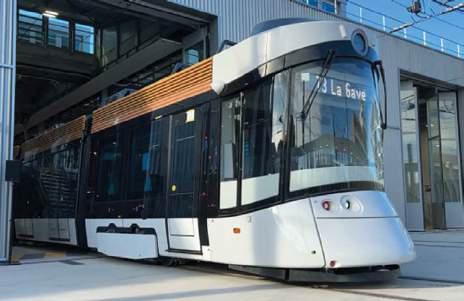
ARAD. The photo on page 289 of TAUT 1052 actually shows an exInnsbruck Lohner tram. K. Matzka IA Ș I. The forthcoming threesection Bozankaya 100% low-floor trams will be numbered 223350. The first was exhibited at the EurasiaRail exhibition in Istanbul in June.
A new tram depot is to be built on the site of the demolished bus garage at a cost of EUR60m. BS
KALININGRAD. Gortrans increased fares from 26 July: from RUB37 (EUR0.39) for cash payments and from RUB33 (EUR0.35) for cards. Drivers’ wages were increased on 1 July from RUB85 (EUR0.91) per hour to RUR185 (EUR1.98) per hour J. Carpenter
MOSKVA (Moscow). A supply contract has been signed with Transmashholding for 704 new metro cars, to be delivered by the end of 2027. It includes a 30-year maintenance contract. RGI SANKT PETERBURG (Saint Petersburg). Park Pobedy metro station closed on 29 June for reconstruction work that will last until August 2027. During this time, new tram line 29B is to run between Tram Depot 1 and Prospekt Yuri Gagarin on weekdays. transphoto.org
SARATOV. Tram service resumed on lines 4 and 6 on 1 July after completion of infrastructure work between 6th Dachnaya and School No. 52.
The first six 71-911EM lowfloor trams have entered service on line 6. transphoto.org SMOLENSK. A total of eight trams are to be fitted with Ust-Katav 71-623 partially low-floor tram bodies by 2026. transphoto.org
SAUDI ARABIA
RIYADH. The metro carried 18 million passengers in its first six months of operation. The
176km (109-mile) system serves 85 stations. saudigazette.com
BEOGRAD (Belgrade). A protest camp that disrupted the tramway system was cleared by 09.00 on 26 June, enabling services on lines 2L, 5, 6, 7L, 10, 12, 13 and 14 to resume. Sporadic demonstrations have continued. transphoto.org
MASS RAPID TRANSIT. The first of 25 new Mitsubishi automated two-car sets entered service on the Sengkang – Bunggol metro feeder line on 15 July. IRJ
BRATISLAVA. The 3.9km (2.4mile) Jungmannova – Južné mesto tramway extension opened on 27 July. It is served by line 3 to Rača, which operates every 2.5 minutes at peak periods. This line is likely to be the first to receive 49m Škoda trams. skyscrapercity
SOUTH KOREA
INCHEON. Metro line 1 was extended from Gyeyang to Geomdan Lake Park on 28 June. The 6.8km (4.2 mile) extension cost EUR501m to build. urbanrail.net
PALMA. The 1.4km (0.9-mile), EUR34.9m metro line M1 extension from Universitat (UIB) to Parc BIT opened on 3 July. urbanrail.net TARRAGONA. Civil engineering contracts worth EUR16m for the 14.7km (nine-mile) first phase of the Tramvia del Camp de Tarragona (Cambrils Nord – Vila-séca) have been awarded. Stadler is preferred bidder for seven 210-passenger trams. Construction should start this autumn and the tramway could open in 2028. This is to be the start of a 46km (29-mile) system. RGI VALENCIA. The metro’s south line re-opened on 27 June, having
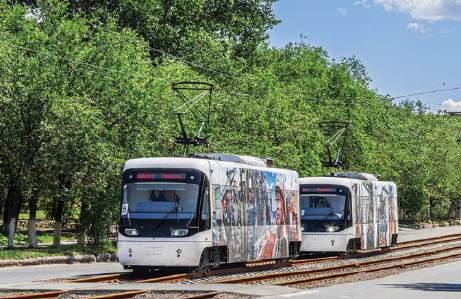
taken eight months to fix the flood damage of late 2024. BS
GENEVE (Geneva). Construction of the 5.5km (3.4-mile) tramway extension from Nations across the border to Ferney-Voltaire in France was to start in September. Due to open in December 2028, it is to be worked by line 13.
The extension of cross-border line 17 from Parc Montessuit to Perrier-Aubrac is due to open before the end of 2026. BS
INTERLAKEN –GRINDELWALD/ LAUTERBRUNNEN (BOB). A further five ABeh4/8 have been ordered from Stadler for delivery in late 2027. This will permit both lines to be operated every 15 minutes. EA LOCARNO – DOMODOSSOLA (FART). The first Stadler ABe6/12s are now in service. The vehicles they replace – Abe4/6 52-54 and Abe4/8b 45-48 – have reportedly been sold to Ferrovia Genova – Casella. EA ZÜRICH. A CHF53m (EUR45m) order for a further ten Flexity trams has been placed with Alstom; 4123-32 are to be delivered in 2029. Cory SAS is to supply a Flexity simulator for CHF2.5m (EUR2.7m).
Delivery of the Garaventa cars for the Rigiblick cable tramway took place at the end of June. It should reopen on 26 September. BS
TAICHUNG. A ground-breaking ceremony for the 24.8km (15.4mile) metro Blue Line (Taichung Port – Railway Station) took place on 26 June. Completion is planned for 2034.
RGI TAIPEI. The 14.3km (nine-mile) elevated Sanyang MRT line from Tucheng to Yingge via Sanxia looks set to open in March 2026. It is to use 29 HyundaiRotem twocar trains. skyscrapercity
BLACKPOOL. Blackpool Transport’s extension to North Station generated 250 000 journeys in its first year of operation. It opened on 12 June 2024.
EDINBURGH. Trams are to run all night every Friday and Saturday in August to cater for the festival season. A 30-minute service will link key locations, such as the Edinburgh Playhouse, Usher Hall and Traverse Theatre. Ingliston park-and-ride car park is to open overnight.
LONDON (DOCKLANDS). A new, reduced timetable was introduced on 21 July. This is to permit the start of the changeover between older stock and the new CAF B23 trains.
LONDON (GENERAL). Trams, buses, and trains on the Overground, Docklands Light Railway and Elizabeth Line, are to receive wraps marking 25 years of Transport for London. The look features a commemorative roundel and key milestones from the past 25 years and will be in place for the rest of the year.
MANCHESTER. Investment in green public transport is being hailed as the reason why air pollution in Greater Manchester is decreasing. The numbers of areas across the city that recorded illegal levels of nitrogen dioxide decreased from 129 in 2018 to 34 in 2024.
The programme of rail replacement between Piccadilly Station and Piccadilly Gardens has moved into its final phase. This section is one of the busiest on the network, with a daily average of 300 tram movements. Work between Piccadilly Gardens and Portland Street took place 17-19 July while Aytoun Street – Auburn Street was to be addressed 19 July-10 August. Some GBP147m (EUR169m) is being invested in renewals across the Metrolink network up to 2027.
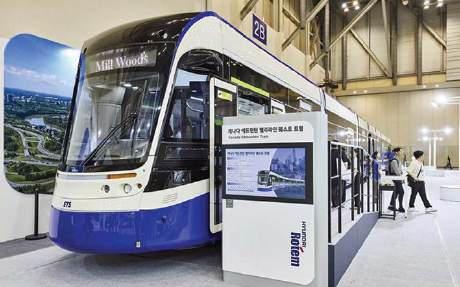
NOTTINGHAM. Nottinghamshire Police and Nottingham Express Transit have launched a trial offering enhanced support, monitoring and evidence gathering from around the tramway network. As well as preventing crime, the aim of the trial is to analyse trends and to develop solutions. If successful, it will become permanent.
SHEFFIELD. Hitachi Rail and South Yorkshire Mayoral Combined Authority have signed a 15-year Technology Partner Framework Agreement to develop technology to modernise the Supertram network.
TYNE & WEAR. The Metro is to be closed between Hebburn and South Shields on 4-8 August to enable 1600m of contact wire and catenary to be installed. A contactless payment system has been installed at five Metro car parks: Four Lane Ends, Bank Foot, Northumberland Park, Regent Centre and Stadium of Light.
WEST MIDLANDS. West Midlands Metro has invested GBP90 000 (EUR103 722) in a new control room simulator at its Training Academy in Wednesbury.
LOS ANGELES, CA. The USD1.5bn (EUR1.3bn) 14.6km (9.1-mile) light rail extension from Azusa to Pomona is to open on 19 September. Requests for Proposals have been issued for the design and construction of the 5.3km (3.3-mile) final section of the Foothills light rail line from Pomona to Montclair. J. May PHILADELPHIA, PA. The Southeastern Pennsylvania Transportation Authority (SEPTA) Board approved the Fiscal Year 2026 budget on 26 June, with 45% service cuts and 21.5% fare increases. Cuts to rail and bus services were due to take effect
on 24 August. More severe cuts may come in January, with tram lines 10 and 15 being replaced by buses as well as a reduction in Red Arrow bus services. J. May PORTLAND, OR. Siemens had delivered 27 of the 30 Type 6 cars by 17 July; 14 are in regular service.
S.J. Morgan
SAINT LOUIS, MO. Repainting of the MetroLink fleet in the blueand-black livery was to have been completed in early August 2025. Most were full repaints but some cars have received vinyl wrap. Destination blinds have been replaced by LED indicators in all but the 1000 series LRVs. This is because the 18 active 1000 series cars will be replaced by the new 5000 series LRVs in the next few years.
S.J. Morgan
SAN FRANCISCO, CA (Muni).
The F-line heritage tramway escaped the service cuts that took effect on 21 June. In fact, four additional weekend runs have been added until 12 October. 2025’s guest cars have included Melbourne 496, Blackpool Boat 233, Muni 1 and Brussels PCC 737 (in Zürich livery). Guest cars can be seen on Fridays and Saturdays departing Cameron Beach yard at 11.57 and running downtown on the J/F lines. Market Street Railway
MUSEUM NEWS
BALLARAT (AU). Yarra Trams has donated Melbourne Z3 116, built in 1979, to the tramway museum. Yarra Trams
has joined the museum collection at Woluwe. T-2000
BEAMISH (UK). Sunderland 16 and Sheffield 264 have been turned out in fictional Armley Corporation Tramways livery as part of a filming contract.
EAST ANGLIA TRANSPORT
MUSEUM (UK). The redundant 1905-built former Great Eastern Railway signal box from Oulton Broad North station has moved to the museum’s Carlton Colville site.
Rebuilding of Glasgow 488’s top deck is at an advanced state. The next stage is to lift it onto the bottom deck, which was restored by the Ffestiniog Railway in 2013.
NORTH WALES (UK) . The Llandudno and Colwyn Bay Tramway Society has taken its replica Llandudno & Colwyn Bay tram 7 (built from Bournemouth Corporation 126) to local events throughout spring and summer. The road-mounted tram body was to appear in Colwyn Bay on 2 August.
THE WIRRAL (UK). The next Hooton Park Hangars open day is on 31 August. The former aerodrome to the south of Birkenhead contains three Merseyside Tramway Preservation Society collection trams (Liverpool 43
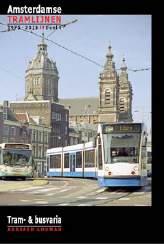
and Douglas Bay Horse tramway cars 11 and 47) as well as Chester Corporation Tramway 4.
Worldwide items for inclusion should be sent to Michael Taplin at Flat 8, Roxan Villa, 33 Landguard Manor Rd, Shanklin, Isle of Wight PO37 6EA, UK. Fax: +44 (0)1983 862810 or e-mail miketap@mainspring.co.uk
UK and Ireland items are welcomed by the Home News Editor, John Symons, 17 Whitmore Avenue, Werrington, Stoke-on-Trent, ST9 0LW, UK. E-mail: uknews@lrta.org
Acknowledgements are due to: Blickpunkt Straßenbahn (BS), cimtchau.ca, cm-sintra. pt, CNGL, Drehscheibe (DS), Eisenbahn Amateur (EA), International Railway Journal (IRJ), La Presse, lineoz.net, Market Street Railway, mdr.de, Op de Rails (OR), praguemorning.cz, Railway Gazette International (RGI), saudigazette.com, skyscrapercity, Tram-2000 (T-2000), tramwayforum.at, transphoto.org, Transport Publiczny (TP), urbanrail. net, Urban Transport Magazine (UTM), Vlada Kantona Sarajevo and Yarra Trams.
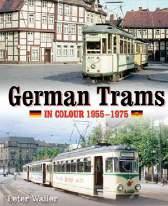

The National Trolleybus Association is selling two collections of recently acquired European tramway books. The collections consists of several hundred titles collected over many years and include books from the 1950s up to the present.
For a detailed list please see the NTA website, or contact NTA Sales at ntasales@outlook.com Or phone/text 07772709563
NTA Sales, 22 Sandfield Road, St Albans, Herts, AL1 4LA, UK.
S.J. Morgan
BROOKS, OR (US). TriMet Type 1 LRV 101 was moved to the Oregon Electric Railway Museum on 17 July after its last day in service on 2 June. It will not be able to carry passengers until the overhead wiring is modified for pantographs, which is expected to take several years.
BRUSSEL/BRUXELLES (BE). PCC 7065 returned from its visit to Den Haag (The Hague) on 21 May. Articulated PCC 7735 of 1972

Across the light rail community, people pay heartfelt tribute to Geoffrey Claydon, an industry icon who passed away at the end of June leaving behind a powerful legacy.
On 22 July, light rail professionals, enthusiasts and friends gathered at Crich and Derby Cathedral to honour the remarkable life and legacy of Geoffrey Claydon CB.
It began with a deeply moving tribute at Crich when Geoffrey was carried for his last ride through the Museum on Blackpool 166, followed by Glasgow 22 and Chesterfield 7 –a subtle but powerful reflection of a lifetime spent in passionate service to the Tramway Museum Society (TMS) and the wider light rail sector.
Mike Crabtree from TMS says: “I knew Geoffrey for 66 years, and remember standing outside Swinegate Depot in Leeds on that miserable wet and misty night on 7 November 1959 as we watched the last trams enter the depot for the last time and the doors slam shut. We could not have
“His impact can be seen in every tram that runs at Crich and across the country. His wisdom shaped the laws that protect and empower our sector. His presence, over decades of leadership, will never be forgotten.”
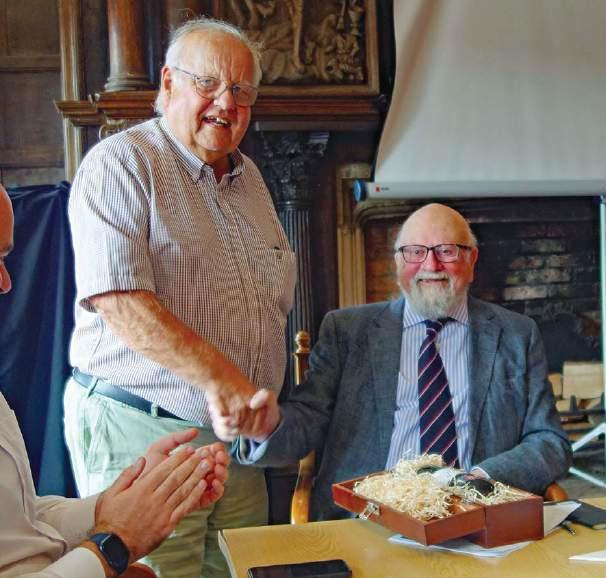
contemplated that by the time of Geoffrey’s passing there would be six secondgeneration tramways in UK plus LUAS, and also that on the day of his funeral, an international light rail conference was taking place in Leeds (the UK Light Rail Conference) but a few yards from where we had been standing some 66 year’s earlier.”
David Frodsham, lifelong friend who gave the eulogy at Derby Cathedral, said: “Over 50 years it is hard to remember Geoffrey ever complaining or losing his temper. As many will know, he was always very grateful for anything done for him. He was extremely intelligent and had the good fortune to remain very sharp until the end of his life.”
Geoffrey was born in Handsworth on 14 September 1930, and developed a keen interest in Birmingham’s trams, supported by regular trips to visit his aunt in Wednesbury. As a pupil at King Edward VI School in Birmingham he encountered other boys with a similar interest.
Encouraged by W. A. (‘Cam’) Camwell, he participated in local tram tours, and in 1944 joined the then Light Railway Transport League (since 1979, the Light Rail Transit Association/LRTA) where he served as Secretary, Chairman, President and latterly as its Patron. He was the guiding force behind the transition of the LRTL Museum Committee into what became the Tramway Museum Society. There he was instrumental in finding a site for the museum at Crich. Not just a pen pusher, he spent his weekends digging drains, concreting floors and building the stone wall in front of the museum’s Tea Rooms.
After obtaining his Bachelor of Law degree at university, he joined the Civil Service, a career that took him to London and eventually to the upper echelons of government. He was Principal Treasury Solicitor and Legal Adviser, Department of Energy, and due to retire when he accepted a project to modernise railway and tramway legislation. This included the repealing of the restrictive Tramways Act 1870, widely regarded as a key factor in the demise of first-generation systems. This work on what became the Transport & Works Act laid the foundation for the development of modern tramway and light rail systems in the UK, ensuring they were built on clear, workable legal frameworks. He was appointed a Companion of the Order of the Bath (CB) in recognition of his government service.
David Keay, Deputy Chief Railway Inspector (lead inspector for heritage railways and tramways), said: “ When we set up the first working group to develop guidance for the tramway industry, Geoffrey was the first on my list. Whilst he was a lawyer, he understood all facets of tramways. He was still providing the industry with advice only weeks before his passing.”
Geoffrey played a key role in reforming the constitution of UK Tram, helping it transition from an organisation of institutions to one open to individual membership. He became a Director and was the founding Chair of its Heritage Group. Geoffrey’s efforts also helped shape what would become LRSSB’s foundational guidance document LRG1.
James Hammett, Managing Director of UK Tram, said, “Geoffrey has done so much for the sector and was a true gentleman. He will be greatly missed. Having had the pleasure of being taken under Geoffrey’s wing, I owe a huge part of my own development and that of the sector to him.
“We have lost not only a true gentleman, but one of the biggest advocates and sector influencers in our time.
“Geoffrey was one of my key mentors/ advocates, from a young age. He will be deeply missed by all, but leaves a legacy not many will ever achieve for the sector.”
Geoffrey also rewrote the LRTA constitution and helped establish it as a limited company. Andrew Braddock, then Chair of the LRTA, says he was “Always the soul of discretion, with a unique ability to calm heated debate and to get the best out of a variety of bodies.”
Geoffrey was the only person to hold the Presidency of the three main UK tramway societies in the UK. In 2005 he received the Transport Trust Lifetime Achievement Award.
Geoffrey’s legal dryness masked a puckish sense of humour. Asked at a wedding in the early 1960s whether he did the Twist, he replied: “Oh no, thank you, I only do the gavotte.”
He was an enthusiastic participant in LRTA tours and travelled the world, visiting tramways and making friends around the globe. Ian Longworth, Vice Chair of the LRTA, who organised many of those trips says: “ I first met Geoffrey as a teenager volunteering at Crich over 50 years ago, and he joined us on many of what became known as the ‘Longworth tours’. His last trip aged 87 in 2018 was to Dubai and Calcutta. He consulted his doctor who said, ‘why not?’ His insurance was a sealed envelope with instructions that if it all went wrong, he would save money and come back cabin baggage! On the trip we all noticed a renewed spring in his step as he thought this would never be possible.”
Many senior figures in the industry counted Geoffrey as a mentor, offering insight, wisdom and encouragement.
Colin Robey, Chair of the UKTram Centre of Excellence, highlights Geoffrey’s extraordinary capacity to influence:
“Many times you have heard someone say that no-one is irreplaceable. Geoffrey came the closest to proving that wrong.”
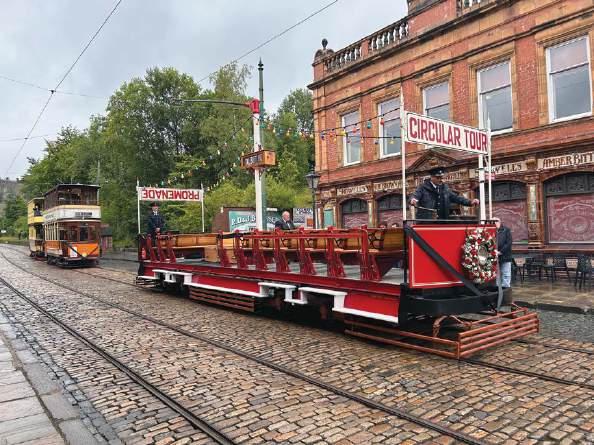
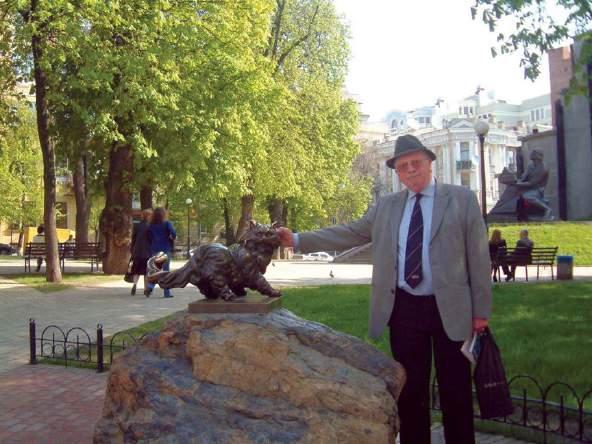
“Many times you have heard someone say that no-one is irreplaceable. Geoffrey came the closest to proving that wrong.”
- Colin Robey, Chair, UKTram Centre of Excellence
A proud Brummie (although talking to him you would never have guessed), his accent was very much that of a Senior Civil Servant. He was active to the very end, only finishing editing a book on Birmingham Tramways a few weeks before he died.
LRTA Chair Paul Rowen, former MP for Rochdale, summed up Geoffrey’s contribution to the light rail sector:
“He was a a titan; witnessing the demise of first-generation trams in the UK he brought about the renaissance of second-generation light rail. Their existence and a vibrant heritage tram sector is his legacy.”
We have become accustomed to news of worthy preservation projects, many of which involve seemingly-derelict examples. But this month we bring news of an imaginative scheme from Belgium that is full of surprises. Mike Russell explains. 1
The Belgian industrial hub of Charleroi once boasted two separate tramway operators –the national SNCV (Société Nationale des Chemins de Fer Vicinaux) system, and the much smaller local network of ‘green trams’. This was formerly the Tramways Electriques du Pays de Charleroi & Extensions (TEPC), subsequently the Société des Transports Intercommunaux de Charleroi (STIC).
The latter had a character all of its own, was a firm favourite with many visiting tram fans, and had endured a torrid co-existence with its ‘big brothers’, with all of which it had seemingly fallen out at one stage or another. Its tramway system – confined to the east and north of the town – finally closed in 1974 and it seemed that nothing would remain to remind us of the pleasure it had given and important role it had once played in the mining communities.
Half a century on from the system’s closure, a six-month long exhibition was set up at the mining memorial at Bois du Cazier, scene of Belgium’s worst pit disaster (1956). This gave rise to discussions between JeanFrançois Meysman and representatives of relevant official bodies about the possibility of bringing the sole survivors of the former STIC network – motor car 310 of 1931 and trailer 12 of 1904 – back to life. This pair had been placed on exhibition at the city’s Palais (formerly Beaux-Arts) tram station since October 1984, and despite some vandalism seemed to have survived in good condition.
In 2003 Luc Meurisse, Jean-François’ father-in-law, built a working 1/5-scale model of 310, one of the ‘green trams’ from the Métallurgiques batch of 1931; it was taken around various local fairs, where it became a popular attraction offering rides to visitors. It seemed that this was destined to be the sole memento of the former STIC network.
However, this March, an agreement was signed between the MTCW (Musée des Transports en Commun de Wallonie) and the ATVC (Association Trams Verts de Charleroi), a society newly formed by Jean-François in December 2024, for the latter to manage STIC tramset 310+12. This agreement paved the way for a firm project to restore the set to working order.
A first stage consisted of the removal of the tramset from Palais station. After a long administrative process, motor car 310 and its trailer 12 were prepared on the night of 3-4 July, by ATVC volunteers supported
by a technical brigade from TEC Charleroi and their works motor car. During this preparatory night, the pantograph was folded up and secured (after the power supply to the station’s overhead line had been partially cut off), the power car’s height was checked, all moving parts and the impact and traction devices were lubricated, and the collectors were cleaned. Hauling and mechanical braking tests were then carried out, and finally the convoy was brought to the end of its exhibition platform.
A week later, on the night of 10-11 July, transfer to the Jumet depot site was carried out, with the exceptional collaboration of TEC Charleroi. Members of the ATVC completed the preparation of the set, while the operator's fitters and pointsmen put the moving parts of the monument platform points into place.
Once the tramset had been lowered from the platform, it was turned onto the outer triangle of Palais station, flanked by two SJ motor cars from TEC technical services. After this manoeuvre was complete, 310+12 were pulled by TEC’s SJ car 7784 to Jumet via the Chaussée de Bruxelles, escorted by several control brigades protecting the convoy. Several technical stops were made to allow ATVC members to check that nothing was overheating and that everything was behaving normally. The convoy was followed by SJ 9175 breakdown unit, ready to intervene in the event of any problems – which fortunately did not arise.
The set is now parked at the Jumet site, where restoration work will begin. Trailer 12 will leave Jumet in the coming weeks for the workshop of an ATVC partner, to have its windows refitted and its body restored.
In January 2025, the ATVC also organised the repatriation to Belgium of trailer 44 of 1915, which had been in use since 1973 in a peat bog in Normandy. Car 44 is now being housed by one of the association’s partners and is awaiting the start of its restoration, initially planned to be to a static state.
Work on 310+12 will be anything but cosmetic. All mechanical and electrical parts will need to be overhauled and tested before any thought can be entertained of operating it over the Charleroi network. But that is the firm plan. It is hoped to have the cars ready for the inauguration of the M5 line to Châtelet and Les Viviers, due to open in the second half of 2027. After that, it will remain on the TEC network for special services.
In this way it is hoped to realise a long-held dream, which has evolved over ten years of patient negotiation and planning. Let us hope that all goes well with the restoration and
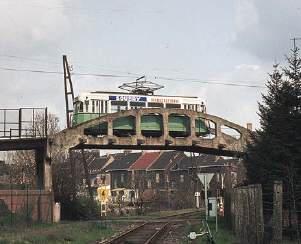
that it will not be long before the streets of Charleroi echo to the sounds and sights of a real STIC tramset. Then we truly will be able to say – the STIC lives!
So why should this restoration scheme seem so important when there are many others in various stages throughout Europe?
The answer is that this is not merely the re-creation of a tramset but representative of a complete tramway network, sadly now deceased – absolutely nothing of the former STIC system survives in Charleroi.
This gallant little tramway had to contend with outright obstruction from the SNCV, local authorities and even the state railways throughout its existence, but nevertheless fought a spirited action to protect its interests and aspirations; the tale of how the TEPC eventually reached Fleurus is the stuff of legend. It also featured some excruciating operating practices – uncoupling a trailer and leaving it unattended in the middle of the main Charleroi – Namur highway ready to be collected by the next inbound car is a classic example of the company exercising its rights as a tramway operator.
The tramscape of the streets and roads through which the TEPC operated were some of the poorest in this industrial conurbation, and much of the surrounding mining and industrial plant was latterly worked out and derelict. Most of that industry has now been swept away, new light industrial estates have sprung up in their place and housing stock has been improved or renewed; it is as though the locality has been determined to remove all trace of the local tramway and its operations that went before. Perhaps this project will redress the balance.
Many older readers of this magazine may well retain fond memories of this little tramway, which oozed atmosphere of a unique kind. The belated recognition of its contribution to public transport in Charleroi and its surroundings will probably rekindle recollections of its operation that even the passage of half a century cannot erase.
Readers who wish to be associated with the project can keep abreast of continuing developments by accessing the ‘Administration and Contacts’ page of the website https://www.atvc.be/
Those who wish to support it financially can make a welcome donation, large or small, through the same website (currently only in French language); currently, all costs are being funded by donations and the private investment of Jean-Francois Meysman.
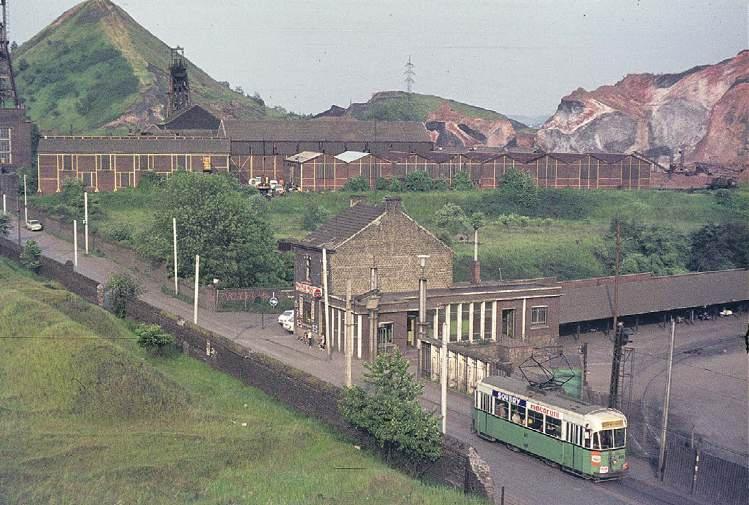
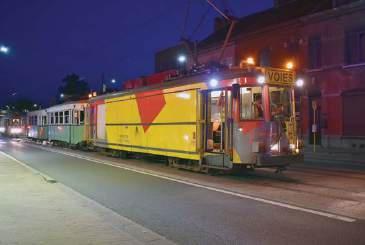
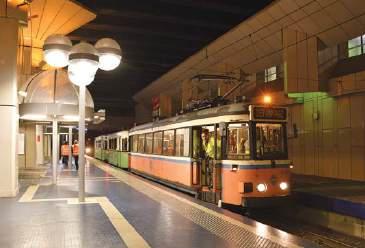
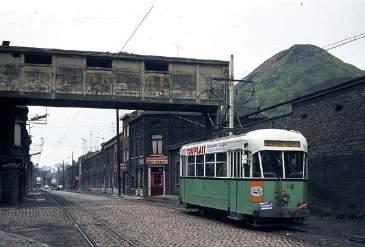
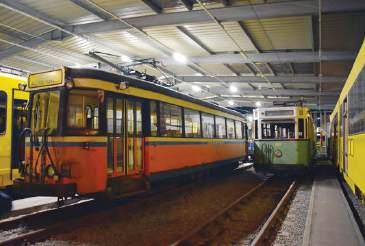
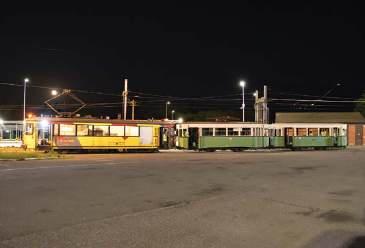
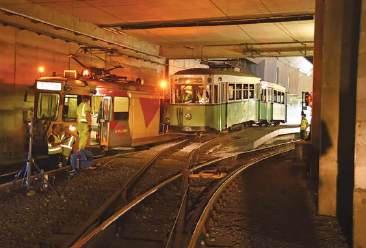
1. One of the tram-only singletrack bridges built by the STIC to cross industrial railways. Tram 411 crosses on its way to Châtelineau on line 15; the rather flimsy approaches provided a ride reminiscent of the ‘ big dipper’ at the UK’s SouthendKursaal pleasure park. Mike Russell – 21 April 1973
2. It’s not a model – it’s the real thing! STIC tram 405 passes through a dramatic landscape of derelict and worked-out industry on the Chaussée de Châtelineau whilst working a trip on the last STIC tram line (15) on 28 May 1974.
Mike Russell
3. The convoy to Jumet was led by TEC SJ works car 7884, with breakdown car SJ 9175 in rear. The consist halted at several points on the journey whilst checks were made to ensure that nothing was amiss with STIC 310 or 12. JeanFrançois Meysman
4. A stranger in the camp at Jumet depot as a STIC tramcar mingles with the usual TEC residents. Jean-François Meysman
5. With TEC SJ works car 9175 in the lead, the STIC vehicles pass through Palais station on the pre-metro network which cars such as 310 and 12 never had the opportunity of serving. Marc Petit
6. Exercise accomplished, the convoy halts outside Jumet depot for this fine broadside shot of the three cars, with SJ works car 7884 in the lead. Marc Petit
7. Car 411 in Rue de Montigny on 21 April 1973, for Châtelineau (line 15) in grimy surroundings typical of metallurgical districts. The slag heap (Puits no. 8) is the result of mining activities at the Trieu-Kaisin colliery.
Mike Russell
8. The first stage of the recovery plan on the night of 10-11 July involved removing the STIC tramset via a temporary ramp and points at the end of the exhibition platform at Palais, where the cars have been displayed for over 40 years. Marc Petit
All photography by Mike Russell unless otherwise stated.

Neil Pulling looks at this major German operator that has seen recent tram renewals and is awaiting replacement of its long-serving Stadtbahn fleet.
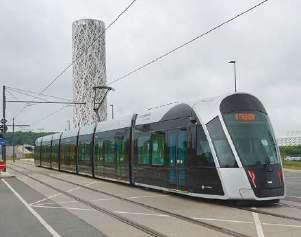
With recent extensions at both ends of the line, Luxtram will continue to grow during the coming years, as Andrew Thompson reports.
+ The diverse uses for light rail: parcel trams and more
+ Classics: Gothenburg ’s historic fleet
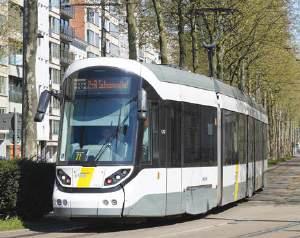
Neil Pulling looks at the evolution and modern developments influencing the light rail system around the historic trading city of Antwerp in Belgium.
+ The latest news and analysis, system and technical development



2025 ISS U E On sale 19 September

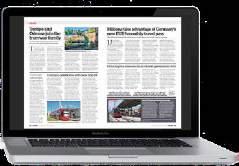

Order online from www.lrta.info/shop – or by post from:
LRTA Publications, 38 Wolseley Road, SALE, M33 7AU (Please provide telephone contact details and quote LRTA membership number if applicable)
Outside UK = Airmail to Europe (includes all of Russia) / Surface mail to rest of world; Airmail Zone 1 = outside Europe excluding Australia, New Zealand & USA; Airmail Zones 2/3 = Australia, New Zealand & USA
Tramways in Milan in Colour (1954-1978)
I tram di Milano – Immagini a colori (1954-1978)
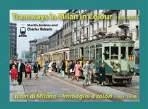
Third in the series of colour albums exploring the fascinating combination of urban and interurban tramways in and around Milan. The variety of rolling stock is amazing and is richly illustrated. English and Italian text.
> A4 hardback, 144 pages, 176 colour pictures plus two maps.
£33.50 (UK); £40.00 (outside UK); £47.50 (Airmail Z1);
£52.50 (Airmail Z2/3); LRTA Members: £3.00 discount
Urban Rail in the Polish Capital Warsaw

This new volume in the series of Robert Schwandl handbooks covers the city’s excellent and growing integrated transport system, with tramways, underground and suburban rail lines described in detail. The former trolleybus system is briefly covered too. German & English text.
> B5 softback, 128 pages, 300+ colour pictures, 14 maps.
£28.50 (UK); £32.50 (outside UK); £35.50 (Airmail Z1);
£37.50 (Airmail Z2/3); LRTA Members: £2.30 discount
Sporvogne og Trolleybusser I Danmark
Udviklingen af linienettene i København, Odense, Aarhus

This interesting book sets out the growth of the tram and trolleybus networks in map form in the three Danish cities where electric traction has featured in both first- and second-generation systems. Includes full route descriptions. Danish text.
> A4 softback, ring-bound, 172 pages, 126 maps.
£49.50 (UK); £58.50 (outside UK); £72.50 (Airmail Z1);
£75.50 (Airmail Z2/3); LRTA Members: £4.50 discount
Order

Tramways and Light Railways of Barcelona, Mallorca and Valencia in Colour (1954-1980)

The first in a series of three books covering many of the tramways and electric light railways operational in Spain in the mid-1950s.
> A4 hardback, landscape format; 144 pages, fully illustrated in colour throughout.
£42.50 (UK); £54.00 (outside UK); £66.00 (Airmail Z1);
£67.50 (Airmail Z2/3); LRTA Members: £3.90 discount
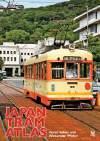
A comprehensive review of the tramways and trolleybuses of Japan with superb track maps for every system. Details of the car types operated and the routes on which they run are covered. English and German text.
> A4 softback; 272 pages, 423 colour and black & white pictures, 48 track maps.
£36.50 (UK); £46.50 (outside UK); £56.50 (Airmail Z1);
£61.50 (Airmail Z2/3); LRTA Members: £3.25 discount

The second in our new series of colour albums covering the historic Lisbon, Porto and Sintra tramways plus the new Metro do Porto and Metro Transportes do Sul light rail networks introduced in 2005/07.
> A4 hardback, 144 pages, 287 colour pictures plus 16 maps.
£33.50 (UK); £40.00 (outside UK); £47.50 (Airmail Z1); £52.50 (Airmail Z2/3); LRTA Members: £3.00 discount
For further details of all these books go to our website.
Edinburgh’s New Trams British Transport Systems Series Volume 14
A succinct and informative review of the planning, construction and operation of the city’s second-generation tramway, including a stop-by-stop description of the Airport to Newhaven route.
> B5 softback, 96 pages, 200+ colour pictures. £16.99 – www.keypublishing.com Strassenbahn Jahrbuch 2025 Strassenbahn Magazin Special No. 40
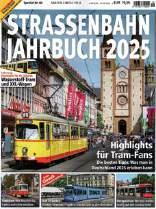
The annual review of tram systems in German-speaking countries with brief reviews from the rest of the world. Features on fifty years ago and tramway museums. German text.
> A4 softback; 116 pages, 300+ colour pictures. EUR19.90 – www.amazon.co.uk









